Hội An is a town where time moves differently. Mornings start with lantern-lit alleys and the scent of cà phê drifting from street corners, afternoons spill into rice paddies and riverside cafés, and evenings glow as the ancient streets fill with soft yellow light.
For digital nomads, Hội An offers a rare balance: a slower pace of life than nearby cities, a rich cultural backdrop, a coworking space surrounded by rice fields, and some of the best vegan food in Southeast Asia.
In this complete guide, we’ll walk you through everything you need to know about living, working, and exploring in Hội An: where to stay and work, the best cafés and restaurants, and what to do when you’re not online—from beach afternoons to cooking classes and countryside bike rides.
Why Hoi An?
Hội An has a way of pulling you into its rhythm. Mornings begin with the quiet hum of bicycles along rice paddies, afternoons drift past riverside cafés, and evenings glow under hundreds of lanterns that make the old town feel timeless. It’s not just beautiful—it’s deeply layered with history, and still small enough to feel intimate.
What makes Hội An distinct from other nomad spots in Vietnam isn’t speed or scale—it’s slowness. You’re never far from something grounding. Cycle to the beach in fifteen minutes, wander into a vegetable village where farmers water crops with seaweed-fed wells, or pause for a bánh mì from a street stall before heading back to your desk. Everything feels close, and everything carries texture.
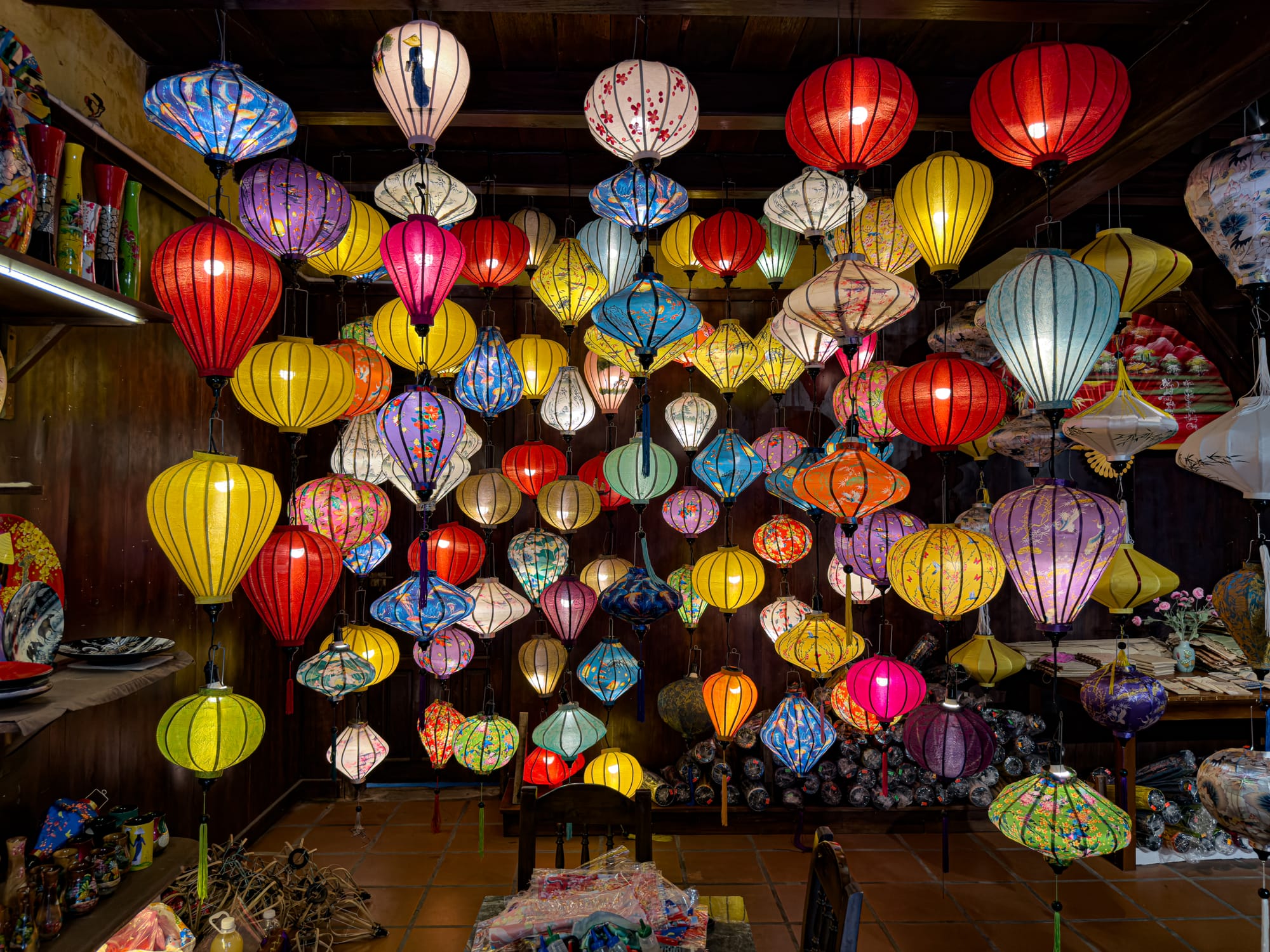
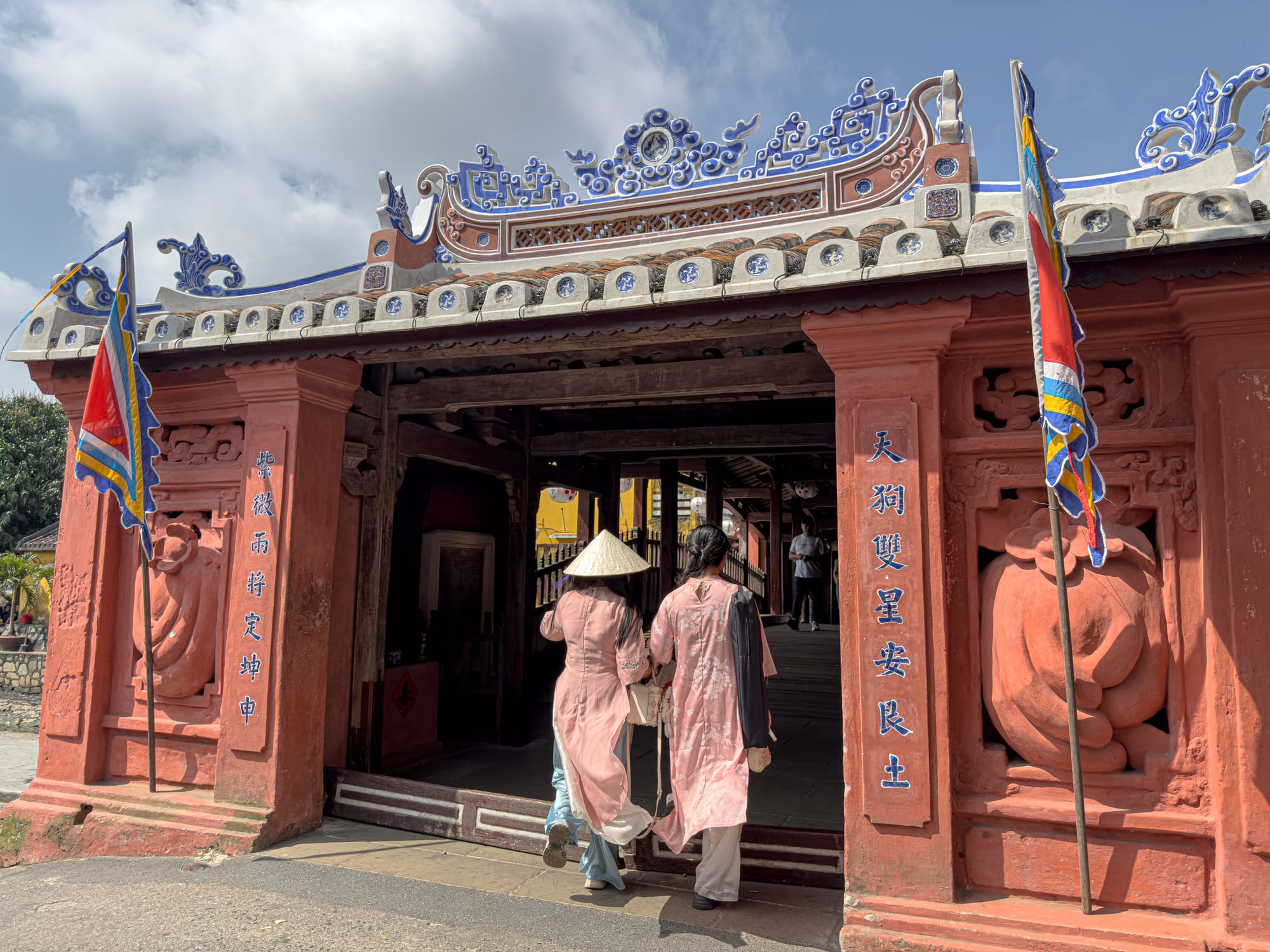
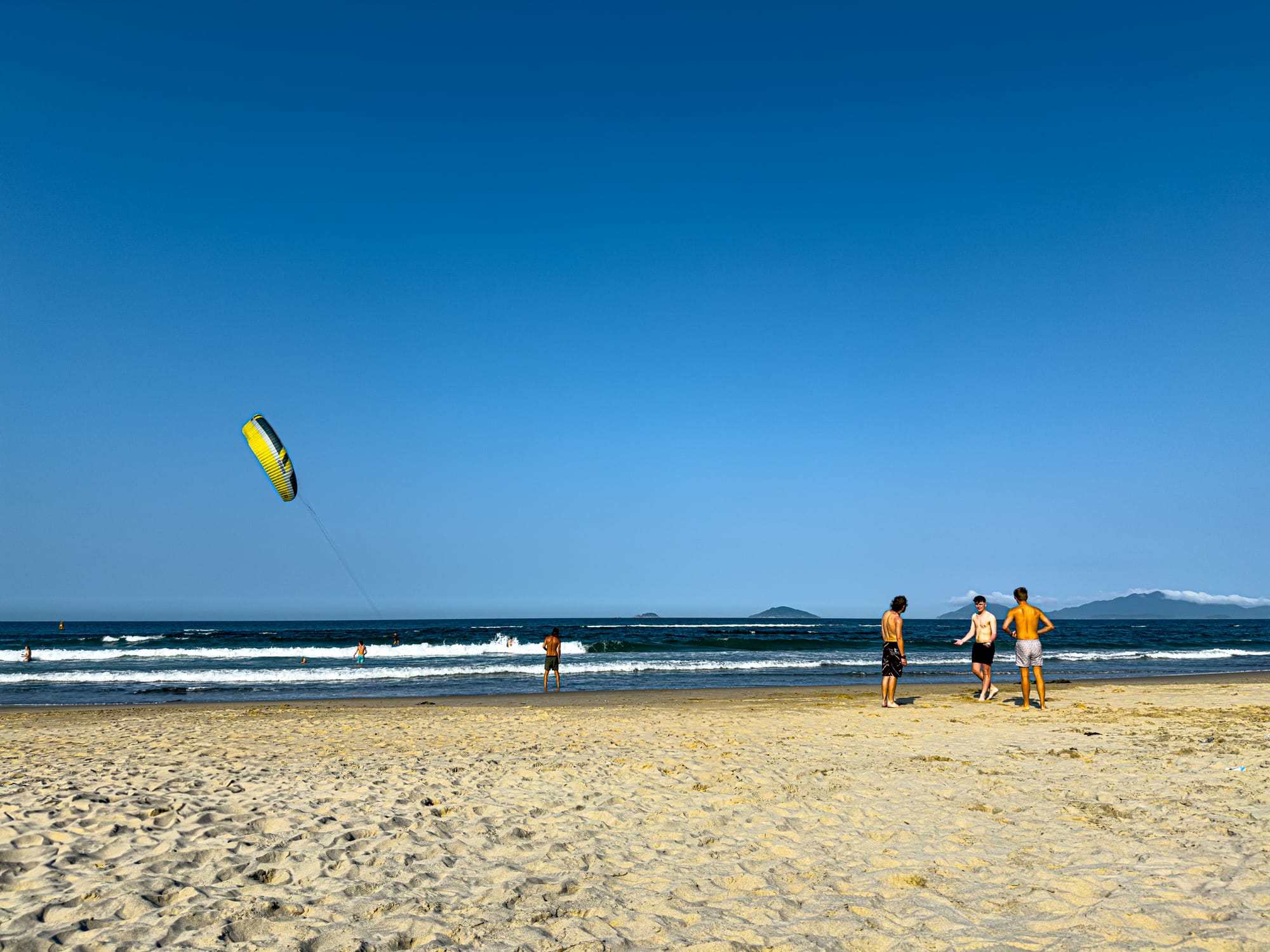
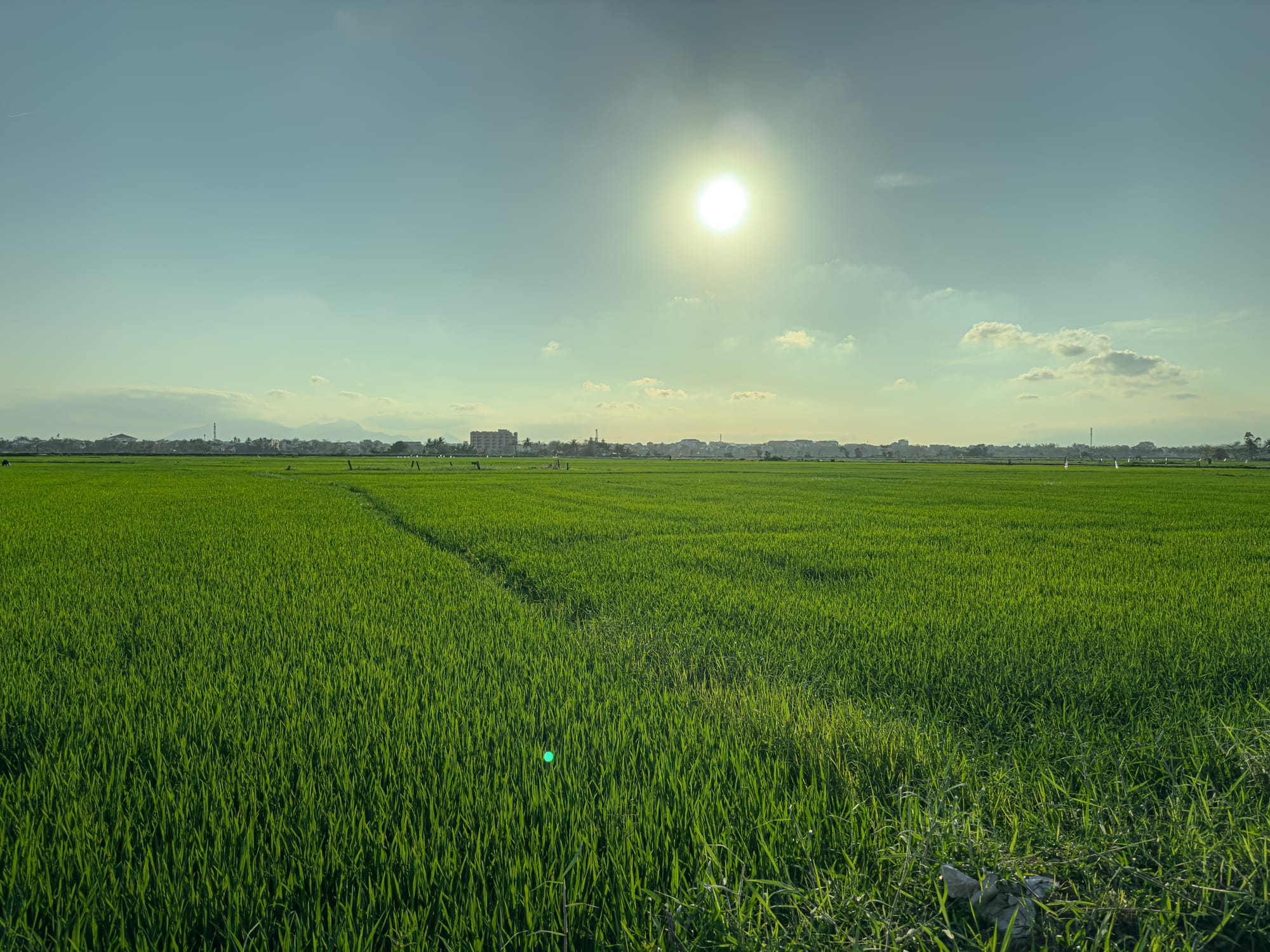
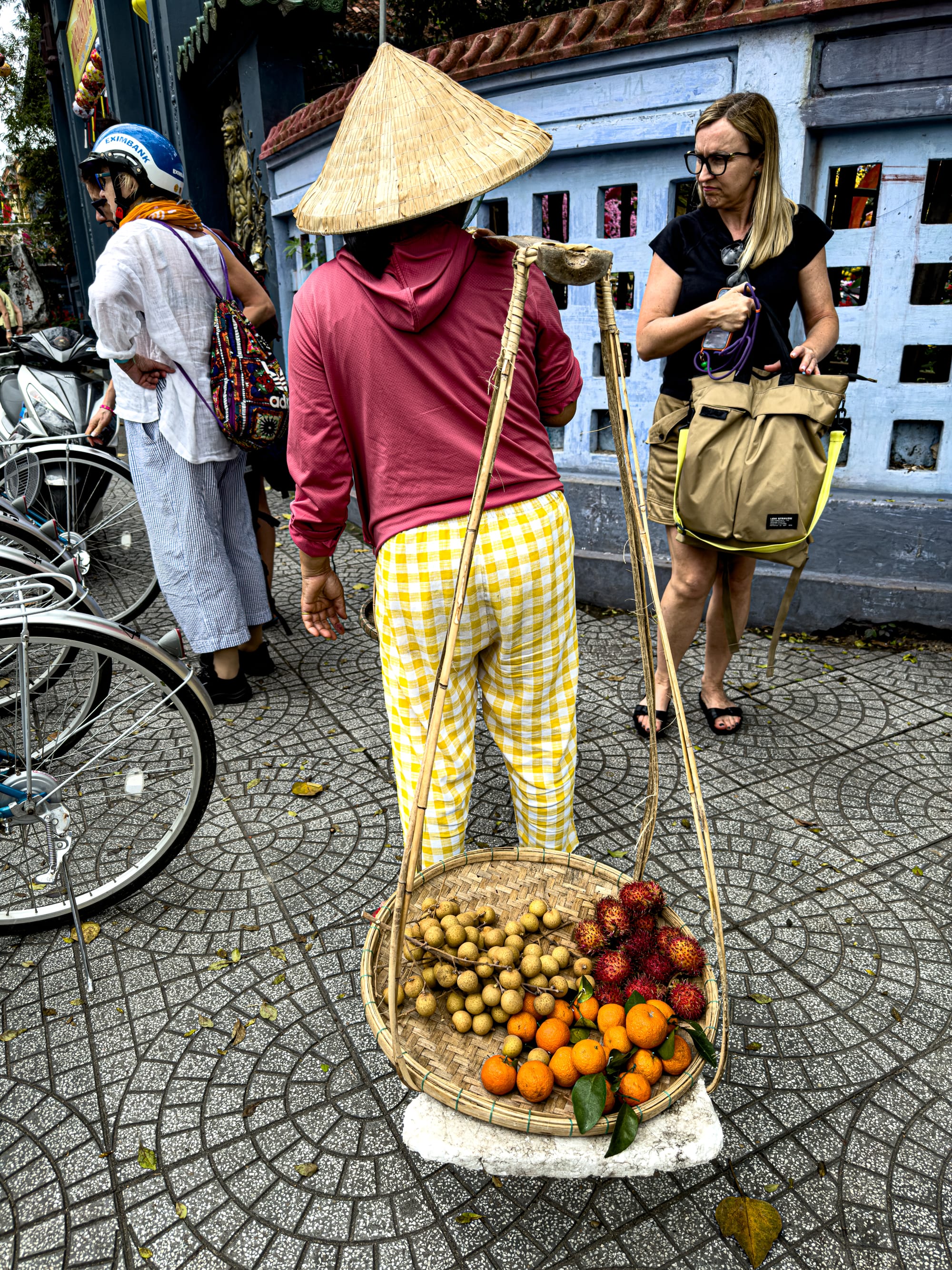
Unlike the bustle of Saigon or Hanoi, Hội An hasn’t been reshaped around remote work. There’s just one main coworking space—Hub Hoi An—set among rice fields, and a handful of colivings that double as community hubs. That smallness is a strength. It attracts people who want to work deeply, eat well, and spend their off-hours exploring countryside roads, beaches, and one of the richest food scenes in Southeast Asia.
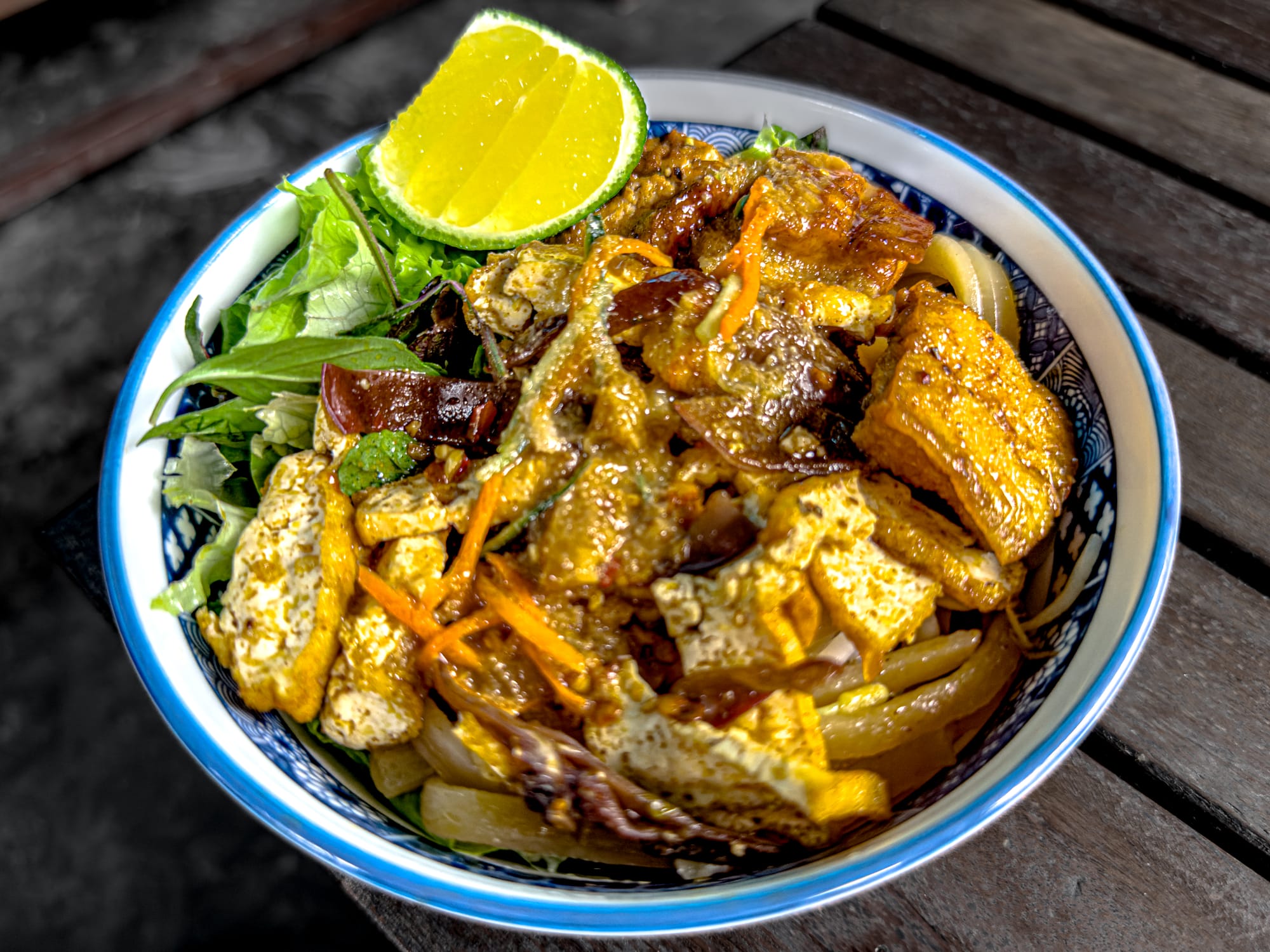
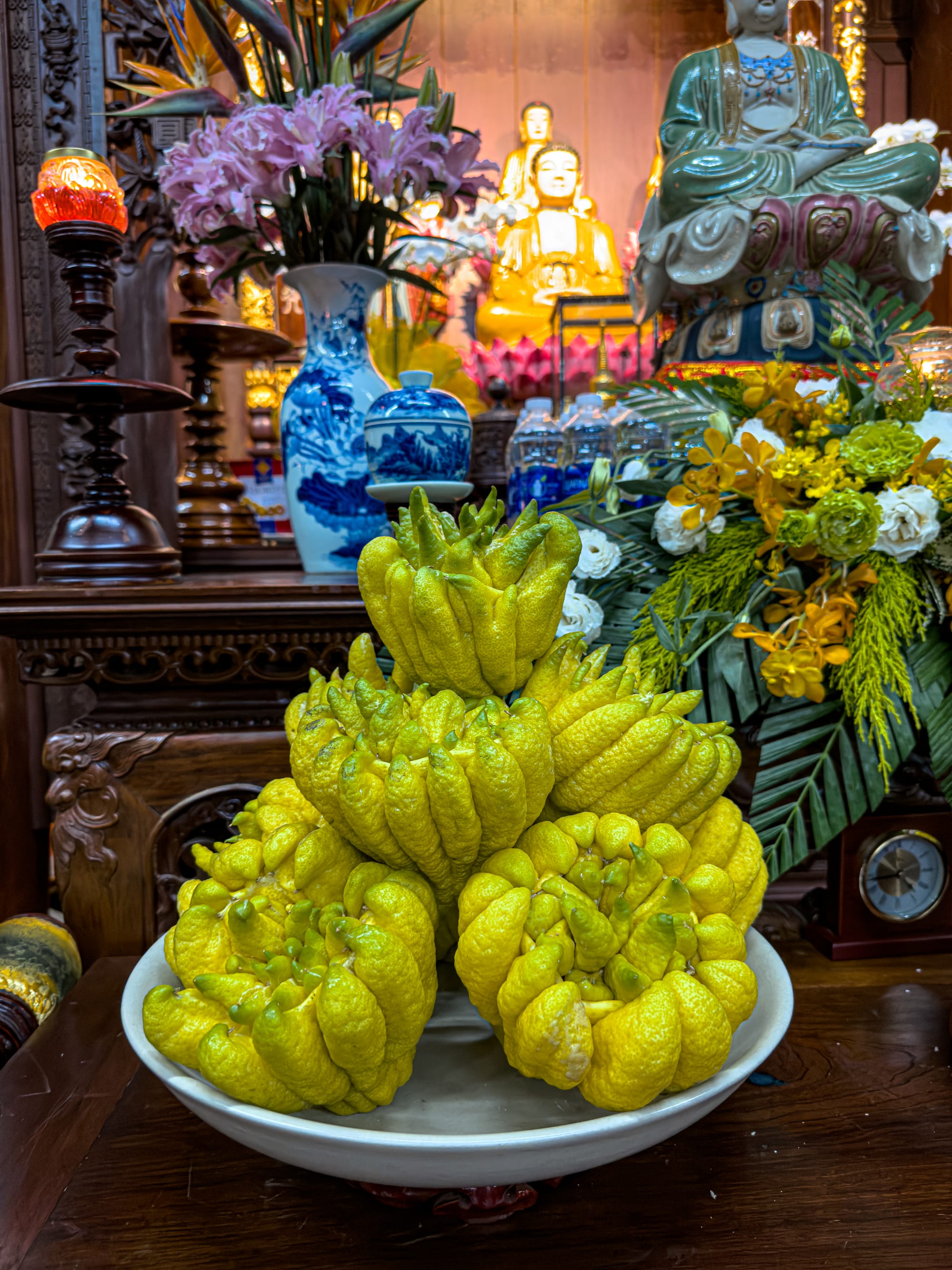
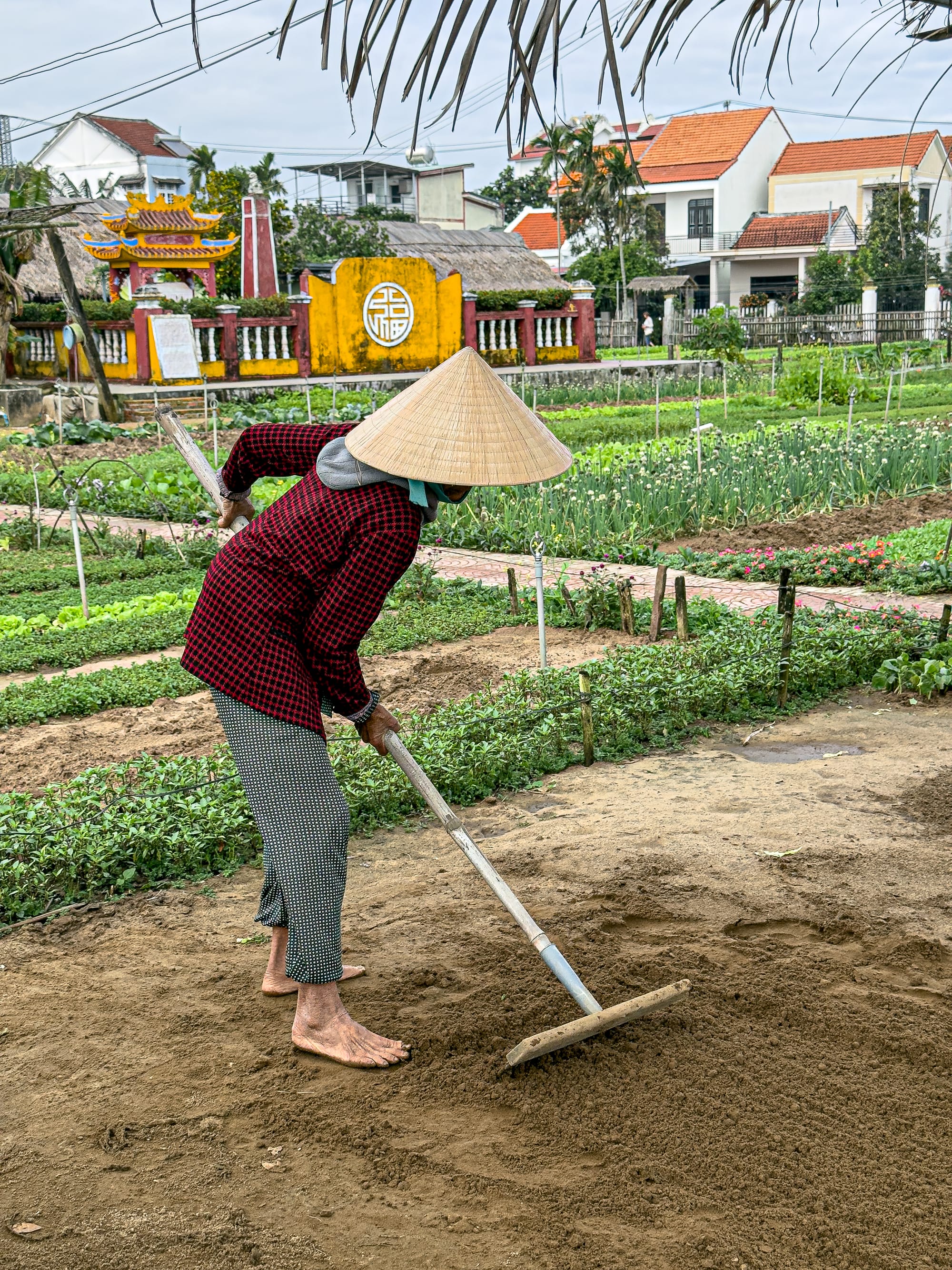
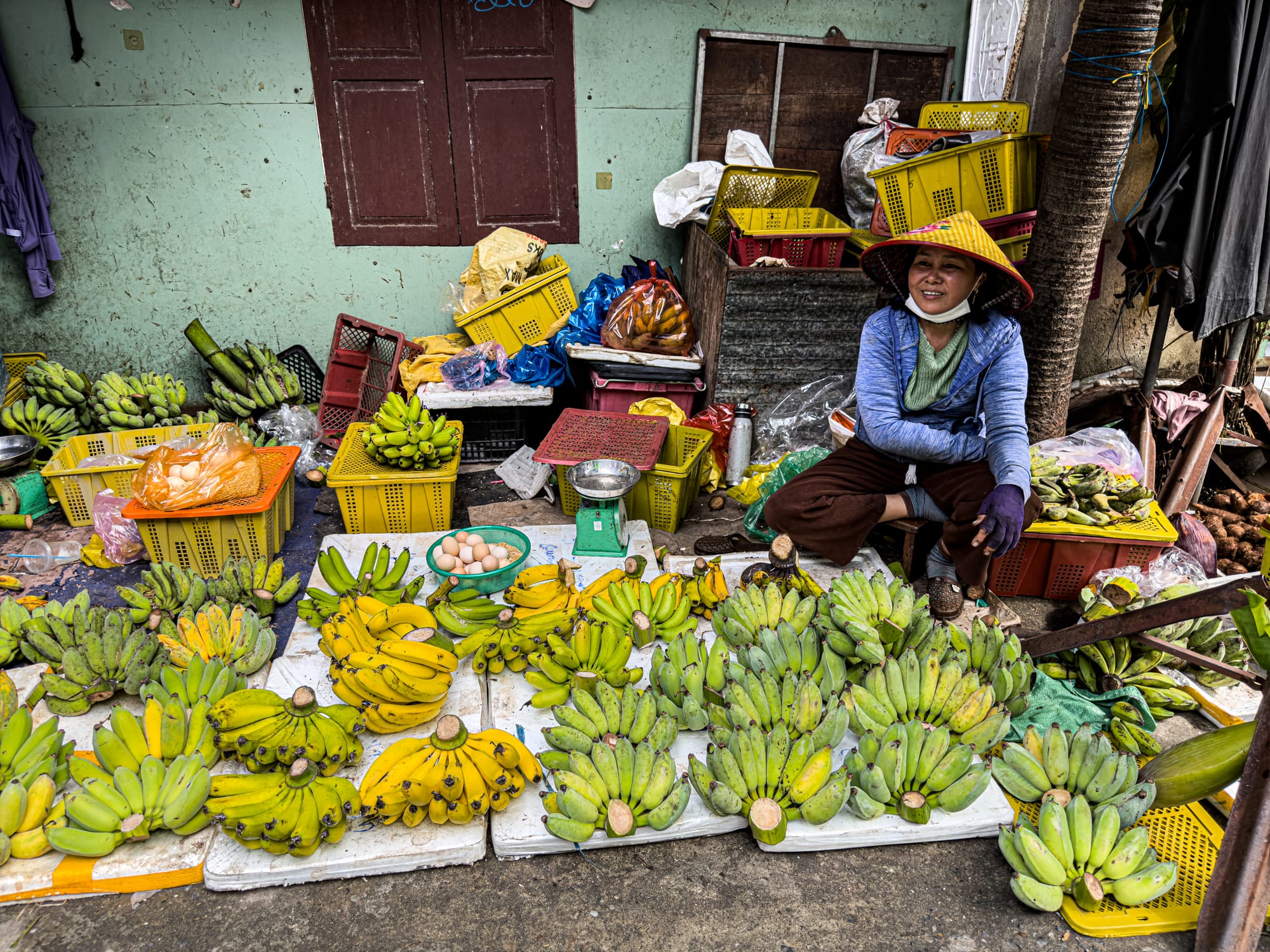
For those working with Western time zones, the schedule can actually work in your favor: mornings are your own for cycling, swimming, or strolling the market, and work begins just as the heat of the day sets in. Evenings often end with a night market wander, a lantern-lit river, or simply the sound of frogs rising from the paddies outside your window.
A town made by hand
What sets Hội An apart isn’t only its lantern-lit streets, but the way craft is still the pulse of everyday life. Step outside the old quarter and you’ll find it everywhere: fields, workshops, kitchens, riverbanks.
At Trà Quế Vegetable Village, farming looks almost ceremonial. Families enrich the soil with riverweed hauled in baskets, water the beds with twin tin cans carried on bamboo poles, and tend herbs that have seasoned Hội An kitchens for centuries. It’s agriculture, but it’s also craft—done slowly, by hand, with memory as the method.
A little further out, rice farming shapes the landscape itself. Most nomads here cycle through rice paddies daily, watching water buffalo plow, farmers plant knee-deep in water, and families work side by side under wide hats. It’s labor, but it’s also artistry: the geometry of terraces, the rhythm of planting, the shimmer of fields that change color with the season. It’s one of the few places where your commute to a coworking space passes directly through the craft of feeding a community.
In Thanh Hà Pottery Village, clay is still thrown, shaped, and fired in traditional kilns. The same families have worked here for generations, supplying bowls, tiles, and jars not just for tourists, but for the households and restaurants that keep the town running. The work is humble, repetitive, enduring—and it leaves a visible trace on the streets you walk every day.
And then there are the lanterns. Step into a workshop and you’ll see bamboo split and bent into frames, fabric stretched and dyed, silk glowing faintly even before the lantern is lit. Many of these workshops are family-run, with skills passed down through generations, each maker adding their own flourishes in color or pattern. By night, the town glows with their handiwork: hundreds of lanterns turning alleys into rivers of light. During festivals, locals float small lanterns on the Thu Bồn River, each one carrying a wish downstream. It’s an everyday art form that has become the soul of the town.
Even in the tailor shops and woodcarving studios, you see the same rhythm. Bamboo bent into frames. Needles pulling thread through fabric. Hands coaxing meaning from raw material. Hội An’s identity has always been made by hand, and that practice continues.
For nomads, this immersion in living craft changes the texture of your days. You might cycle past farmers in the rice fields before your morning call, sit at a pottery wheel one weekend, or spend an evening in a lantern workshop learning how silk meets light. Work feels different in a place where so much is still handmade. Craft isn’t a side attraction—it’s the town itself.
When to go
The best months to visit Hội An are February through April, with March being our personal favorite. The weather is warm but not yet sweltering, the skies are dry, and the rice fields around town are at their greenest. It’s the sweet spot where you can cycle to the beach in comfort, work outdoors at cafés, and still catch the lantern festivals in the old town without the peak summer crowds.
May through August brings the hottest stretch of the year. Expect humid days in the 30°C+ range, strong sun, and busier beaches. It’s a vibrant time to be here—swimming, diving, and day trips to the Cham Islands are at their best—but you’ll want air conditioning for work and plenty of breaks from the midday heat.
September and October are shoulder months with mixed conditions. The rice fields shift golden for harvest, and there are still many bright, clear days. But this is also the start of Hội An’s rainy season, with short but heavy downpours. If you don’t mind rolling with the weather, it can be a rewarding time—fewer tourists, lower prices, and dramatic skies over the Thu Bồn River.
November through January is the true rainy season. Storms and flooding are not uncommon, especially in the old town where the river sometimes spills into the streets. Still, the air cools off, and if you’re here to work deeply in a coworking space and enjoy moody, lantern-lit evenings, this season has its own quiet beauty. Just be ready for wet commutes and occasional closures.
Our advice on the best time to be in Hội An
For a balanced nomad stay, February–April offers the most reliable weather, green landscapes, and a comfortable rhythm for working and exploring.
For beach and island life, May–August is hot but perfect for swimming, diving, and Cham Island day trips.
For photography and festivals, September–October brings harvest colors, fewer tourists, and the Mid-Autumn Festival.
For cozy, rainy-day work vibes, November–January offers cooler air, fewer crowds, and atmospheric lantern evenings—just expect flooding risk.
No matter when you go, pack a light rain jacket and a hat for the sun. Hội An’s weather turns quickly, and part of the charm is watching the town shift with it.
Getting to and from Hoi An
The closest airport to Hội An is Da Nang International Airport (DAD), just 45 minutes away. Da Nang is one of Vietnam’s busiest airports, with frequent domestic flights from Hanoi and Ho Chi Minh City, as well as international connections across Asia—including Bangkok, Singapore, Kuala Lumpur, Seoul, and Tokyo.
For most nomads arriving from further afield, flights typically route through Bangkok, which serves as the main hub linking Vietnam with Europe. From Bangkok, it’s an easy 1.5-hour hop into Da Nang.
For digital nomads combining destinations, Hội An pairs naturally with Thailand—especially Chiang Mai or Koh Lanta, which many nomads move on from before settling into Hội An’s slower pace. It also connects well with Bali, Kuala Lumpur, or even Taipei, making it an easy stop on a broader Southeast Asia circuit.
Working remotely from Hoi An
The anchor for most digital nomads in Hội An is Hub Hoi An, a coworking space set among rice fields just outside Old Town. It’s a calm, leafy spot with reliable internet, shaded outdoor desks, and a steady trickle of both long-term nomads and passing travelers. Community lunches, yoga classes, and social events make it easy to plug in if you want connection, while the surrounding paddies give the place a slower, countryside feel.
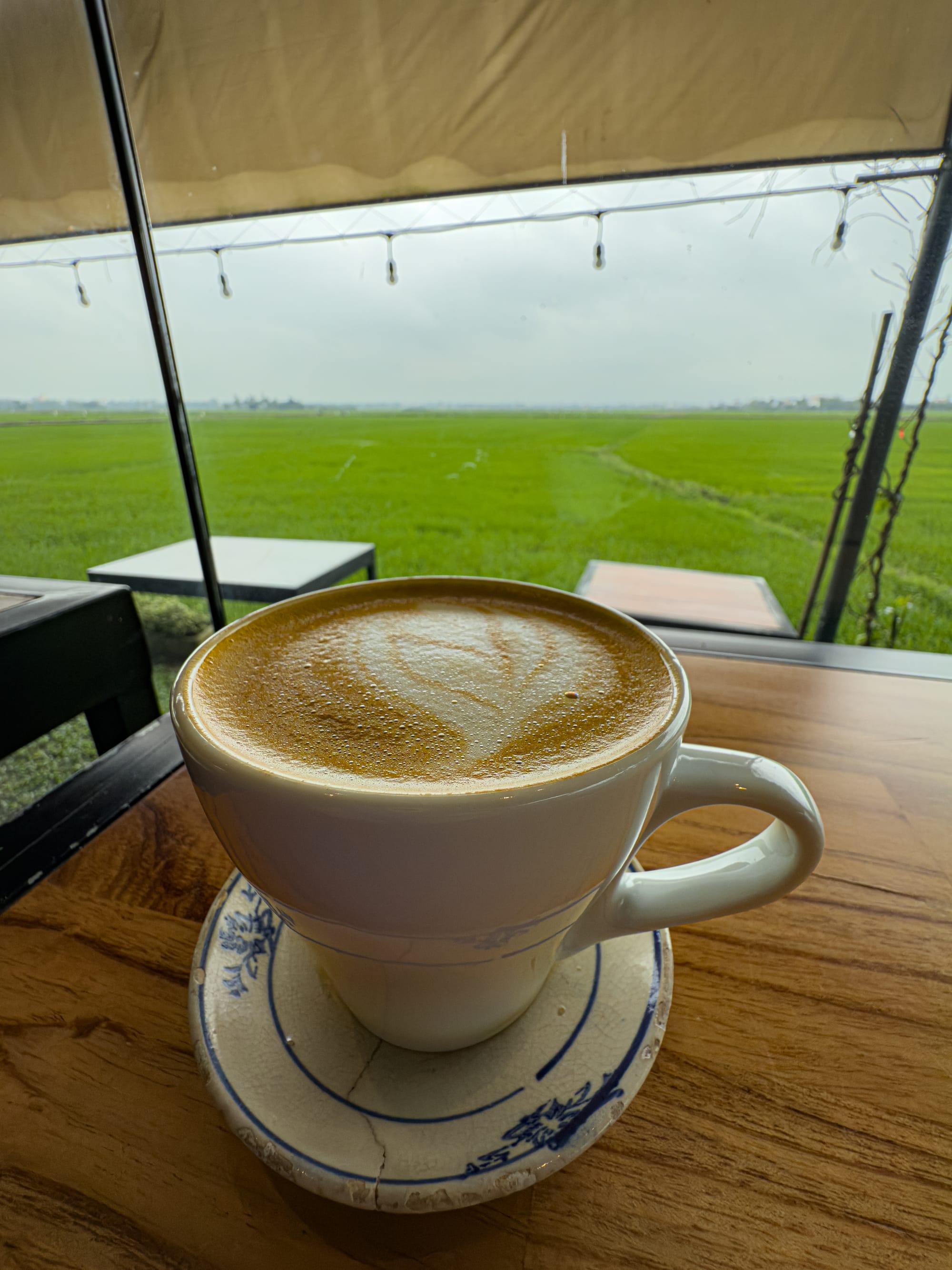
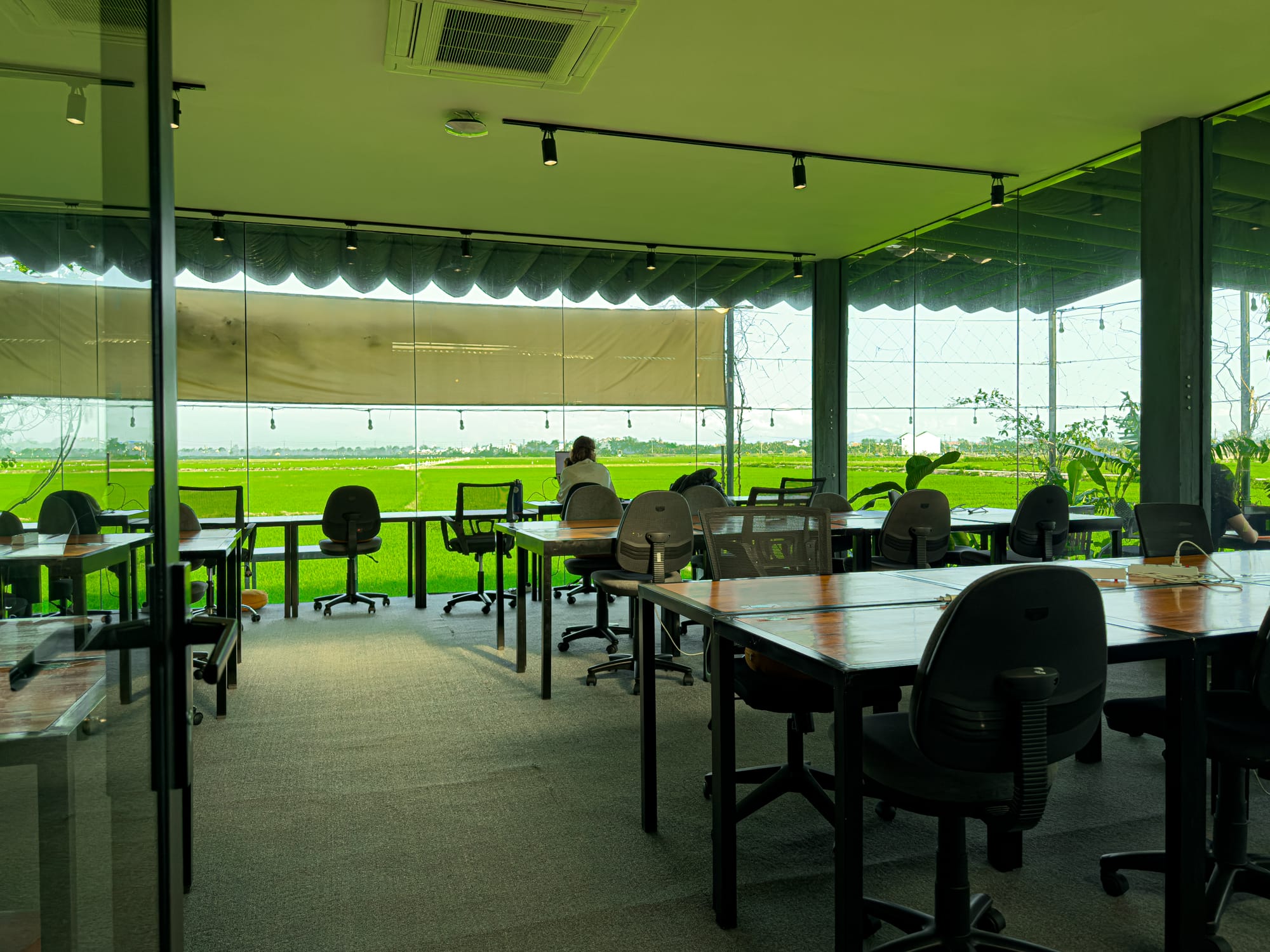
If you prefer café-hopping, Hội An has no shortage of laptop-friendly options. Riverside cafés in the old town and beachside spots often have solid wifi, good coffee, and plenty of outlets. The atmosphere leans slower than big-city coworking cultures like Ho Chi Minh City or Chiang Mai—but that’s part of the appeal. It’s less about efficiency and more about rhythm: typing to the sound of scooters in the distance, pausing for a plate of cơm chay (vegan rice) at lunch, then cycling home past lanterns and rice fields.
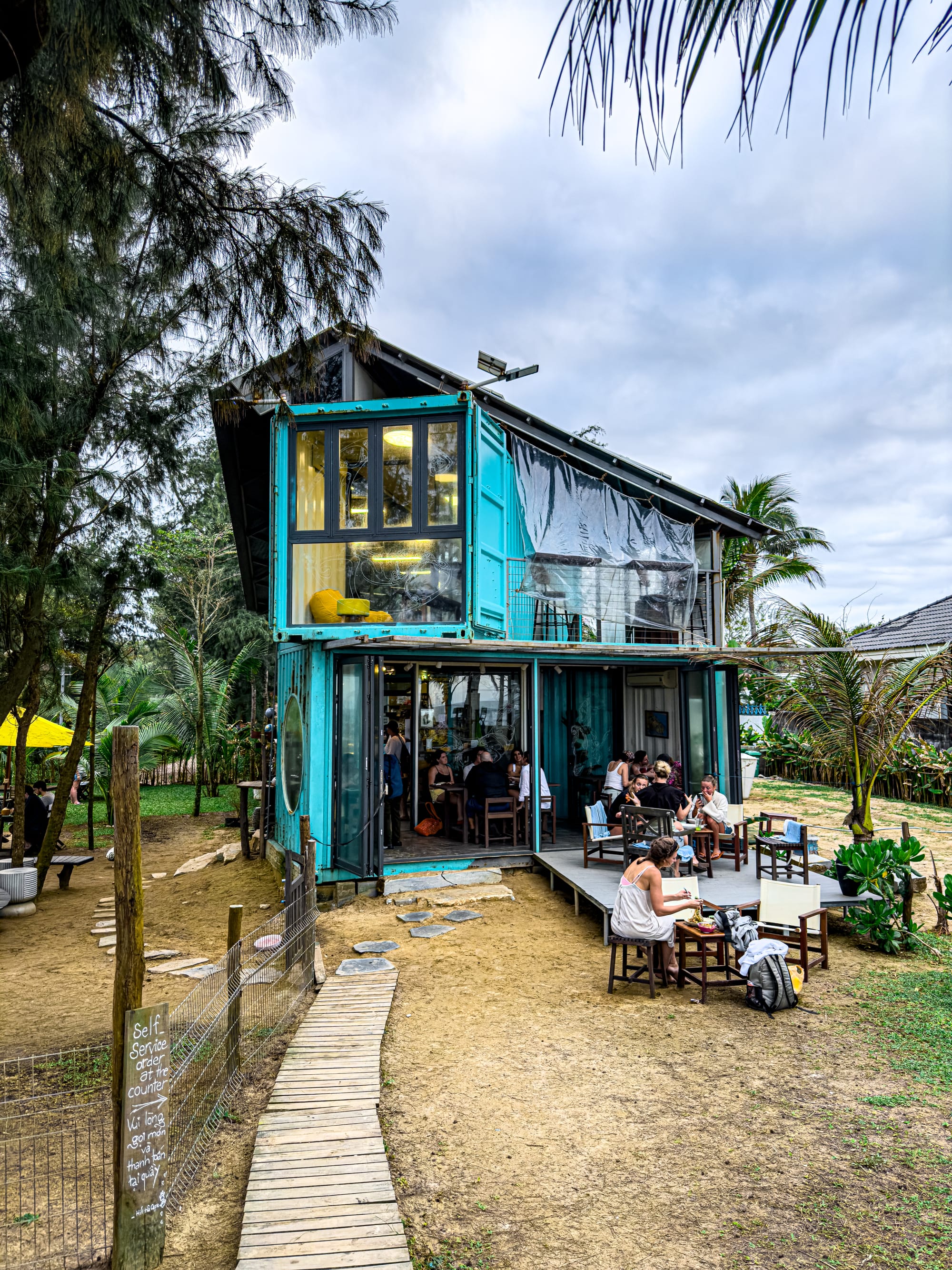
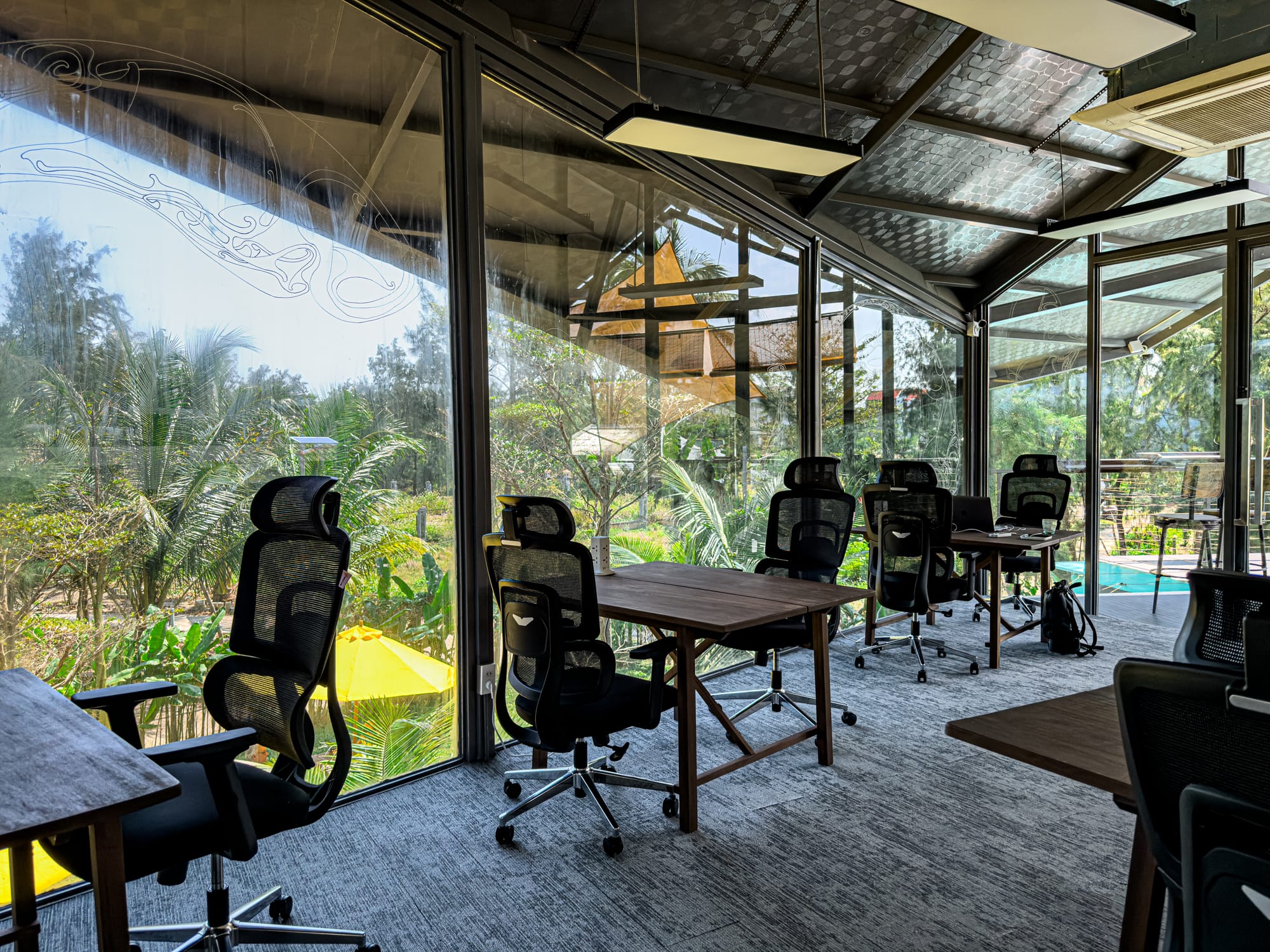
Overall, Hội An is well-suited to deep work. The town’s small size, slower pace, and craft-driven culture mean fewer distractions and plenty of grounding energy. You’ll find yourself working in the mornings, exploring in the afternoons, and unwinding by lantern light in the evenings.
Digital nomad community
Hội An has one of the most welcoming and well-sized nomad communities we’ve come across. The center of gravity is Hub Hoi An. It’s smaller than places like KoHub on Koh Lanta, and that intimacy is a strength—you quickly get to know the faces around you.
Because Vietnam typically allows three-month stays on a tourist visa, most nomads who come to Hội An aren’t just passing through for a week or two. They settle in for a season, which means the community has more continuity than many Southeast Asia hubs. You’ll find regular events hosted by Hub—yoga, skill shares, dinners, and the occasional countryside adventure—as well as plenty of informal get-togethers that flow naturally from working side by side.
What makes it special is the balance: social but not overwhelming, international but still grounded in place. It’s easy to fall into a rhythm of morning work sessions, group lunches, and evenings spent exploring the town or riding out to the beach. Đà Nẵng, just up the road, also has its own nomad and expat scene—bigger, more urban, and full of nightlife—so you can dip in and out depending on your mood.
If you’re just starting out as a digital nomad, Hội An is one of the best places to begin. The community is tight-knit without being cliquish, the pace is gentle, and you’ll leave with a handful of real friends—not just contacts in a group chat.
Hoi An’s culture
Hội An’s culture is inseparable from its history as a riverside trading port. Centuries of Chinese, Japanese, and French influence live alongside Vietnamese traditions—visible in the wooden shophouses, assembly halls, tiled rooftops, and the food you’ll find at every street corner.
Daily rhythms carry a craft-driven, communal feel. Tailors still sew áo dài and suits in small family shops. Lantern makers bend bamboo and stretch silk by hand. Farmers in wide-brimmed nón lá tend rice paddies and water gardens with the same twin-can watering cans they’ve used for generations. In the old town, mornings mean markets—stalls piled high with herbs, vegetables, and tropical fruit. Evenings gather people along the river, whether for a simple bowl of cao lầu or to release paper lanterns into the water.
Festivals give Hội An a unique cultural beat. The Full Moon Lantern Festival transforms the old town every month—electric lights are switched off, thousands of lanterns glow, and the streets fill with music, offerings, and celebration. Tết (Lunar New Year) is another high point, when families prepare altars, share meals, and decorate with kumquat trees and peach blossoms. Smaller festivals tied to fishing, agriculture, or local deities also mark the calendar, each blending ritual and community gathering.
For nomads, you’re stepping into a living culture shaped by craft, family, and festival. Stay long enough, and the cadence of Hội An—the slow mornings, the lantern-lit evenings, the constant hum of making—starts to shape your own rhythm, too.
Psychogeographics
What does it actually feel like to live in Hội An for a month or more? Think bicycle commutes through rice paddies, lanterns glowing softly over the river at night, and afternoons where the air smells of incense, coffee, and nước mắm drifting together. This is a town where mornings might begin with a stroll through the market—pyramids of herbs, tropical fruit, and flowers—and end with a swim at An Bàng Beach or a night ride through streets lit entirely by handmade light.
Life here moves with craft and season. Farmers bend over fields, potters shape clay, tailors stitch áo dài in open workshops. The rhythm is unhurried but steady, a hum of making that becomes the backdrop to your workdays. You’ll notice it seeping into your own pace—calls scheduled around morning bike rides, afternoons broken by bánh mì stops, evenings softened by lantern-lit walks.
Hội An isn’t quiet exactly—it buzzes with scooters, vendors calling out their wares, music floating from temples and coffee shops. But the soundscape is layered, textured, never overwhelming. The palette is amber and green: silk lanterns, water-filled paddies, tiled rooftops glowing at dusk. Rain brings its own mood—heavy showers that flood the streets in minutes, leaving reflections of color and light shimmering in the water.
We wrote a full piece on the texture of life here: Between rice fields and the sea: digital nomad life in Hoi An.
Where to stay
Hội An offers a range of stays—from beachside havens to countryside calm—where you can settle into your work rhythm and the town’s pace. Here are our top picks, organized by location.
By An Bàng Beach
Best if you want to wake up near the sea, be close to cafés and coworking by the beach, and still be a short ride into town.
Athenia Hotel: Just a 5-minute walk from both the beach and Hít Hà Café & Coworking, Athenia offers bright rooms—some with bathtubs or sea views—and an outdoor pool. A comfortable and convenient base by the sea.
Shoreline Stay: Steps from An Bàng Beach in Cam An, Shoreline blends boutique calm with beachfront ease. The infinity pool and sunny courtyard pair beautifully with homemade breakfasts.
Tropical An Bang Beach Villa: Tucked behind sand and greenery in Cam An, this villa offers lush gardens, a pool, spa amenities, and a fitness center. Quiet and leafy, it’s ideal for longer stays.
Rice field retreats and countryside vibes
Best for quiet surroundings, cycling paths through paddies, and being halfway between the Old Town and the beach.
Rêu Boutique Hotel: Surrounded by rice paddies, this boutique stay feels otherworldly with its flowing curved walls. About a 20-minute walk or quick bike ride from Hub Hoi An, it’s perfect for creative retreats.
BS Jade Home: Nestled in Cam Châu, this home features balconies overlooking paddies, an outdoor pool, free bikes, and a friendly staff—calm and inviting.
Charm Champion Villa: Located in Cam Hà, this modern villa offers spacious suites with balconies and private outdoor bathtubs, positioned equidistant from the Old Town and An Bàng Beach.
Anio Boutique Hotel: In Cam Châu between town and beach, Anio combines sleek design with spa touches, dreamy pool, and serene courtyard—ideal for peaceful mornings.
Sunora Villa: A tranquil garden property in Cam Hà, Sunora offers modern rooms, a sparkling pool, and free bikes. Its calm atmosphere is a quiet gem close to both Old Town and the beach.
Old Town adjacency
Best if you want to step out your door and be within walking distance of Hội An’s lantern-lit streets, riverside cafés, and heritage sights.
Nostalgia Hotel: Situated in Cam Phò, just 5–10 minutes on foot from Hội An’s Old Town, this boutique hotel features plush rooms, excellent hospitality, a soothing pool, and spa services. It’s in easy walking distance of the river and heritage streets.
Coliving
Best if you want built-in community, events, and included access to Hub Hoi An’s coworking space.
Hub Hoi An’s Coliving: Set in a villa and including coworking access, this option includes a pool, yoga area, and built-in community. It’s about a 900m path through rice fields to work—more expensive, but ideal if connection matters most.
The best things to do in Hoi An
Hội An has no shortage of things to do.What stood out most to us was the blend of everyday craft, riverside rhythm, and countryside quiet. Think cycling through rice fields to the beach, joining a local cooking class, watching the old town glow at night, and taking day trips that root you deeper in Central Vietnam’s landscape and culture.
This list gathers our personal highlights. We recommend picking a handful that resonate with you, and letting them unfold at Hội An’s pace.
Classic local activities
Explore Old Town
A riverside maze of history and light.
Hội An’s Old Town is a UNESCO World Heritage site, but what makes it memorable isn’t the label—it’s the atmosphere. Wooden shophouses lean into narrow streets, painted mustard yellow and etched with time. Chinese assembly halls with carved dragons sit beside Japanese bridges and French colonial facades, evidence of centuries when the town was a vital trading port. By day, you’ll find tailors stitching áo dài in open workshops, artisans handcrafting lanterns, and markets spilling onto the sidewalks with fruit, herbs, and flowers. By night, the streets glow with silk lanterns, turning the riverfront into a slow-moving festival of light.
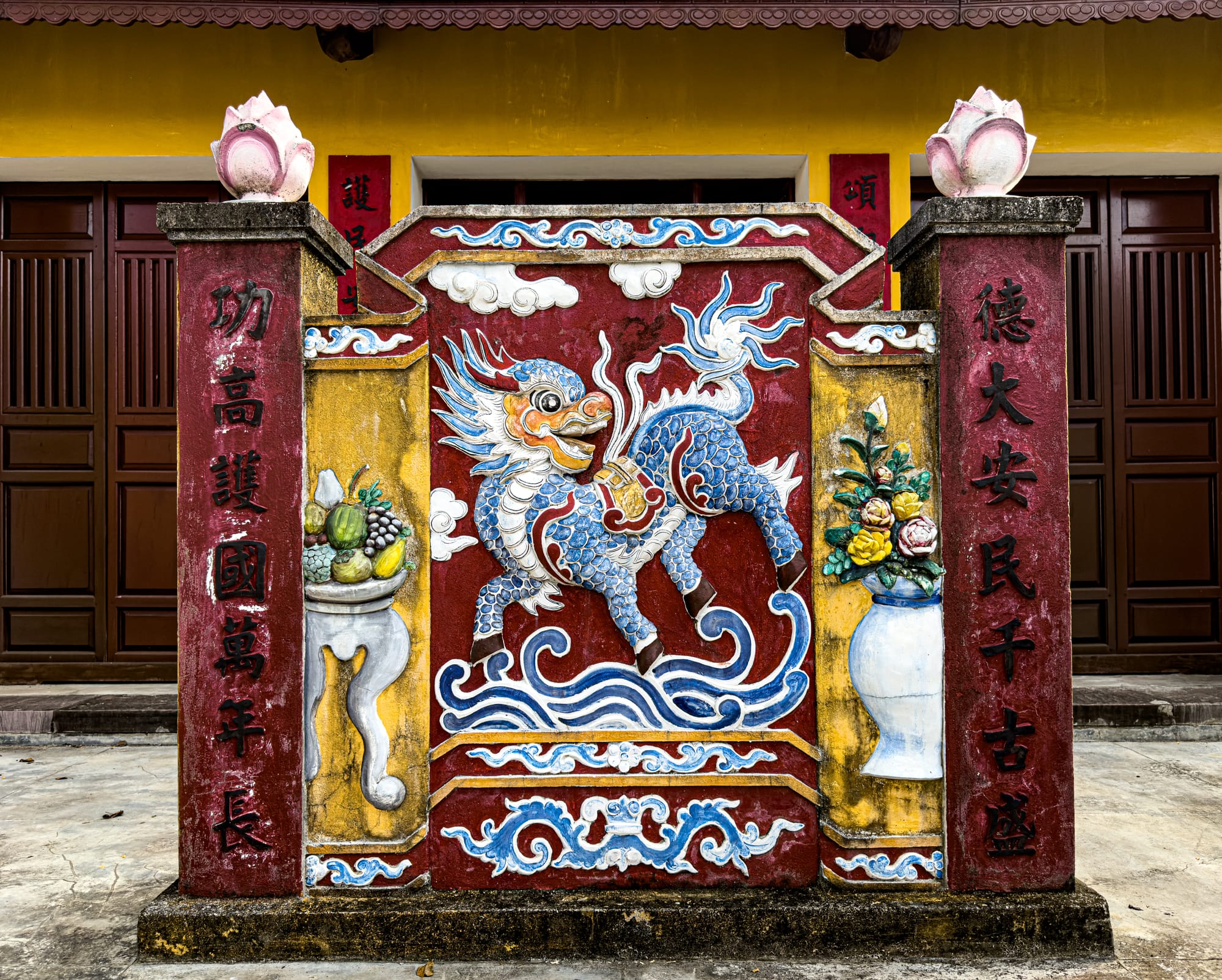
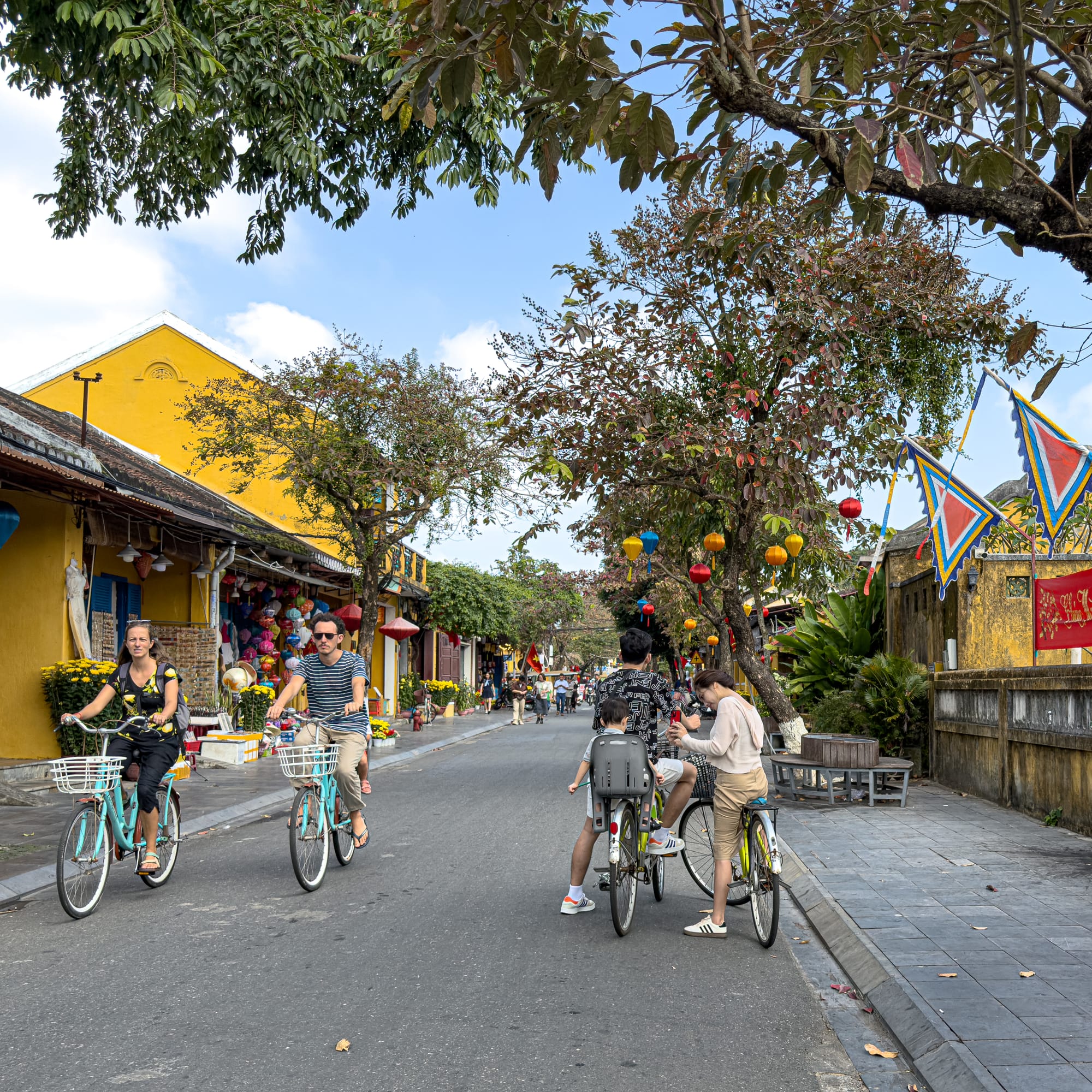
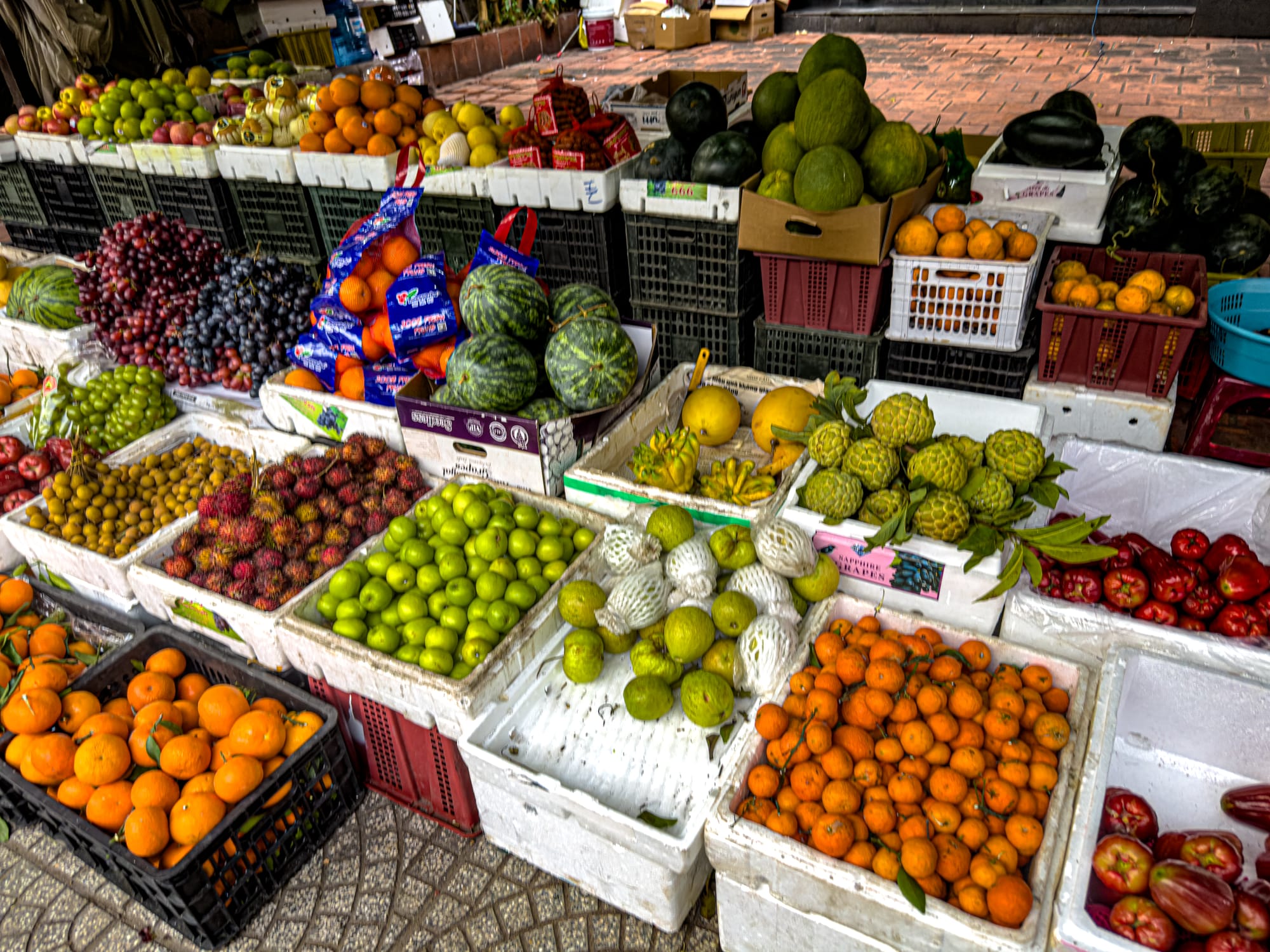
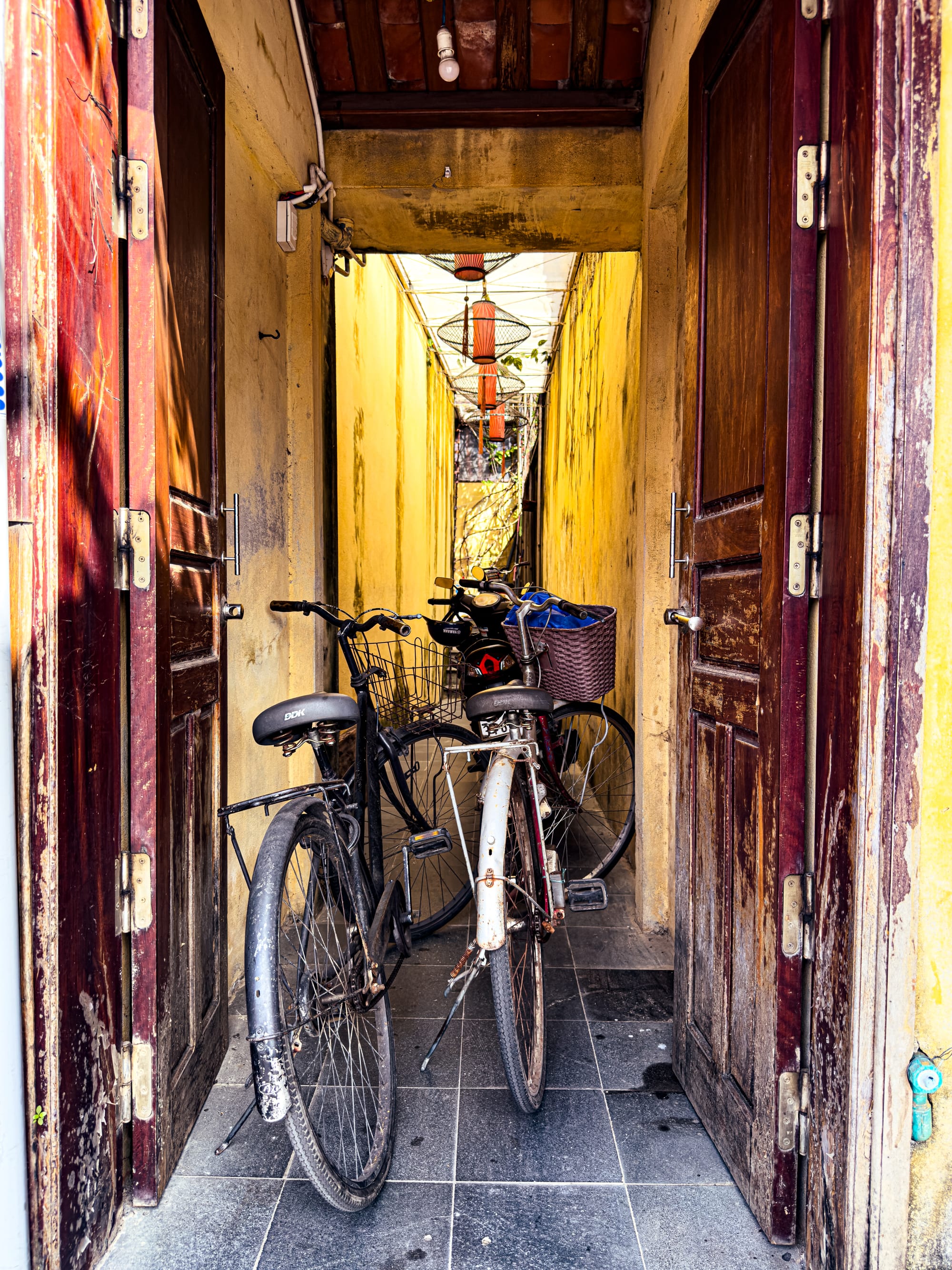
The Old Town is best explored on foot or by bicycle—its small scale makes wandering a pleasure. Each turn reveals a new rhythm: incense curling from a temple doorway, schoolchildren riding past on bikes, vendors calling out with trays of bánh mì or chè. Early mornings are quiet, when locals shop at the market before the tourist rush, while evenings bring music, riverside cafés, and boats drifting under lantern-lit skies.
Ride a lantern boat at night
A short trip on the Thu Bồn River.
One of Hội An’s most recognizable experiences is taking a wooden boat out onto the river after dark. The boatmen line the banks near the Japanese Covered Bridge and the night market, offering 15–30 minute rides under the glow of thousands of lanterns. Each passenger is given a small paper lantern to set afloat, part of a tradition that symbolizes luck and remembrance. From the water, you get a different perspective on the Old Town—the reflections of lanterns stretching across the surface, the sound of street music carrying from the banks.
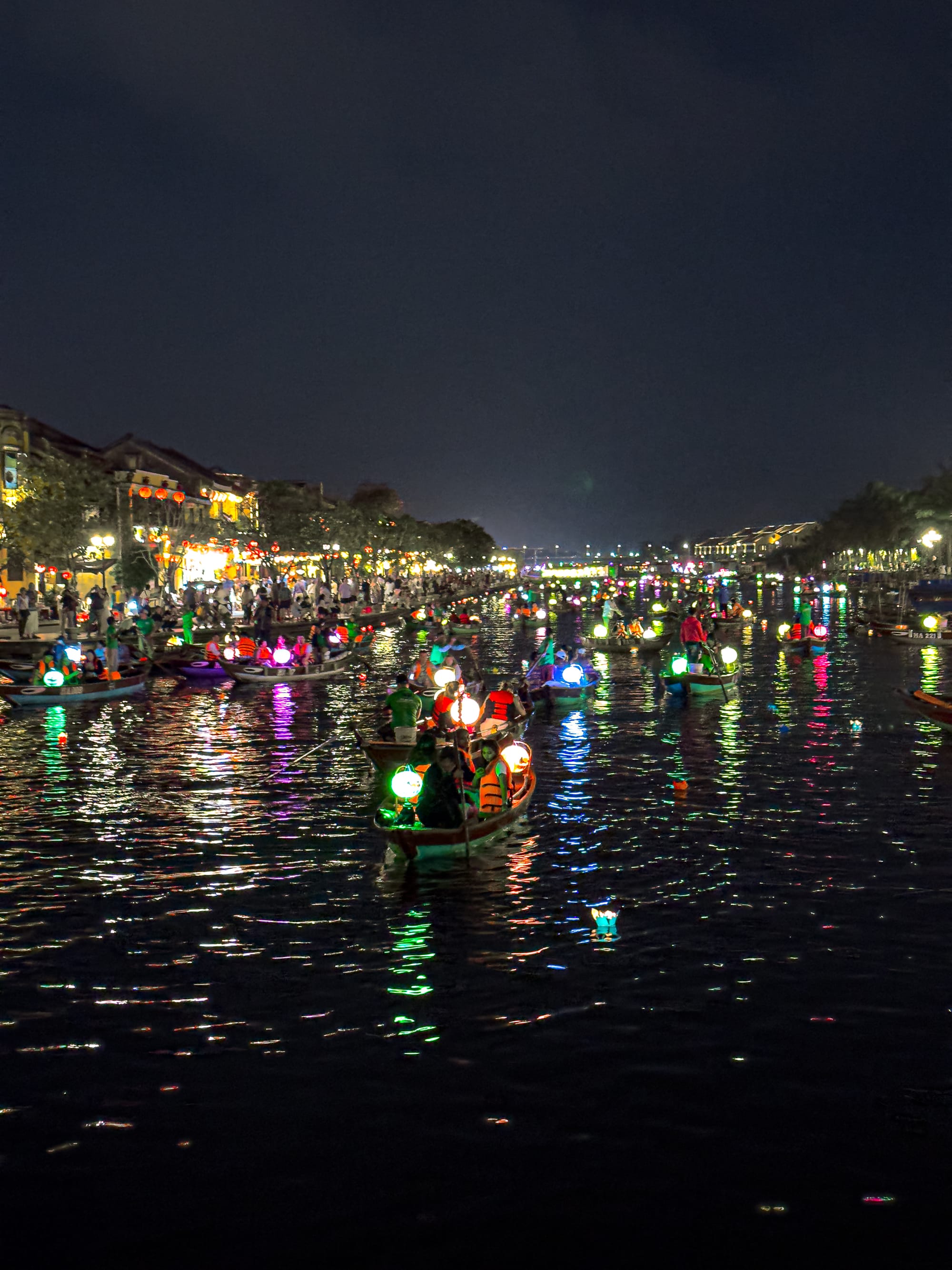
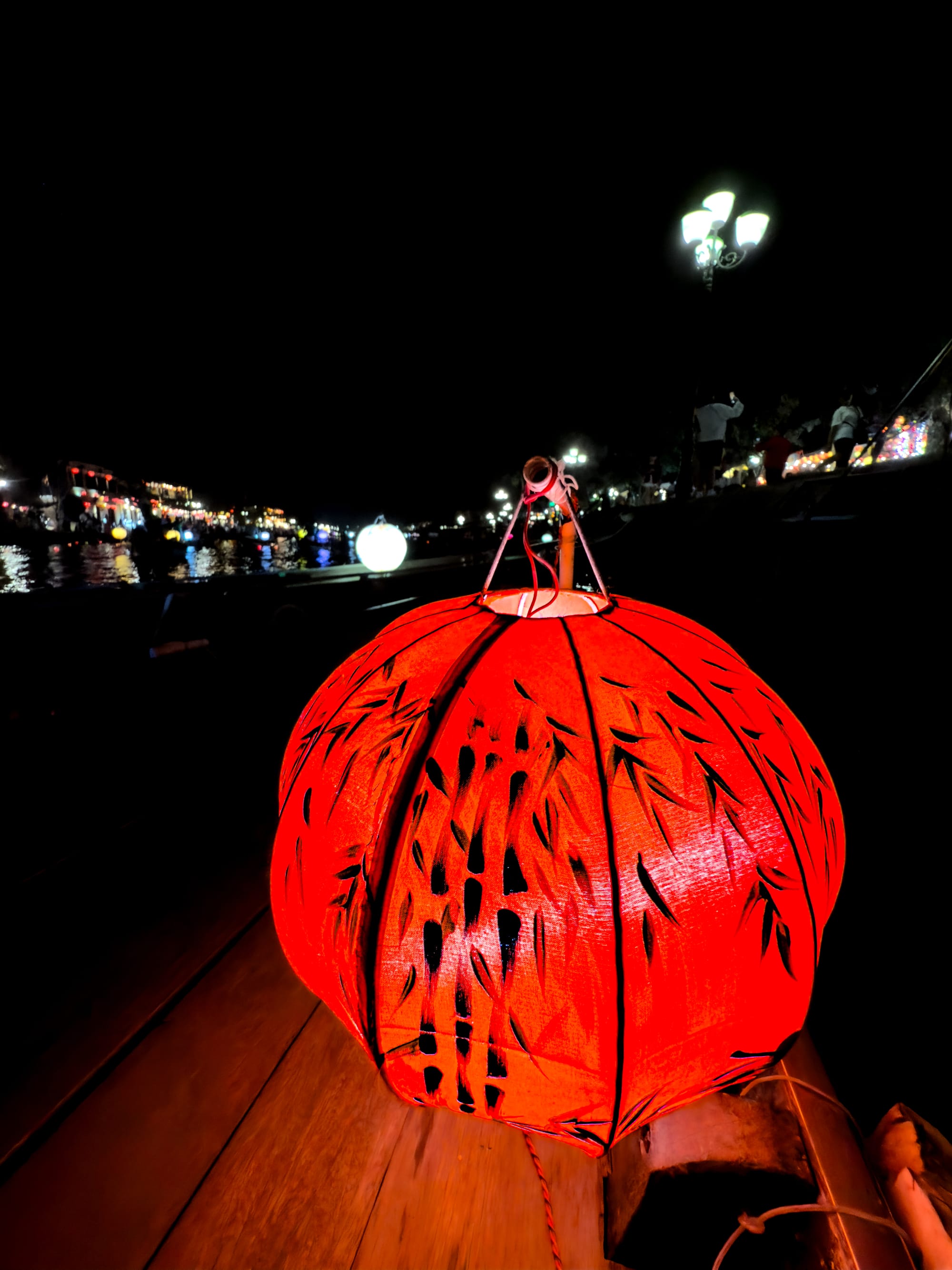
It’s busiest during the monthly Lantern Festival, but boats run every night, and going midweek or later in the evening can mean fewer crowds. For many visitors and nomads alike, it’s a one-time activity, but it’s worth doing at least once for the view of Hội An’s Old Town from the river.
Cycle through the rice fields
A daily rhythm between town and sea.
One of the simplest and most rewarding things to do in Hội An is to rent a bicycle and ride through the surrounding rice paddies. The fields stretch between the Old Town and An Bàng Beach, crisscrossed with narrow paths where you’ll pass farmers tending plots, water buffalo grazing, and small family shrines tucked into the landscape. It’s an easy, flat ride that gives you a feel for the countryside without leaving town behind.
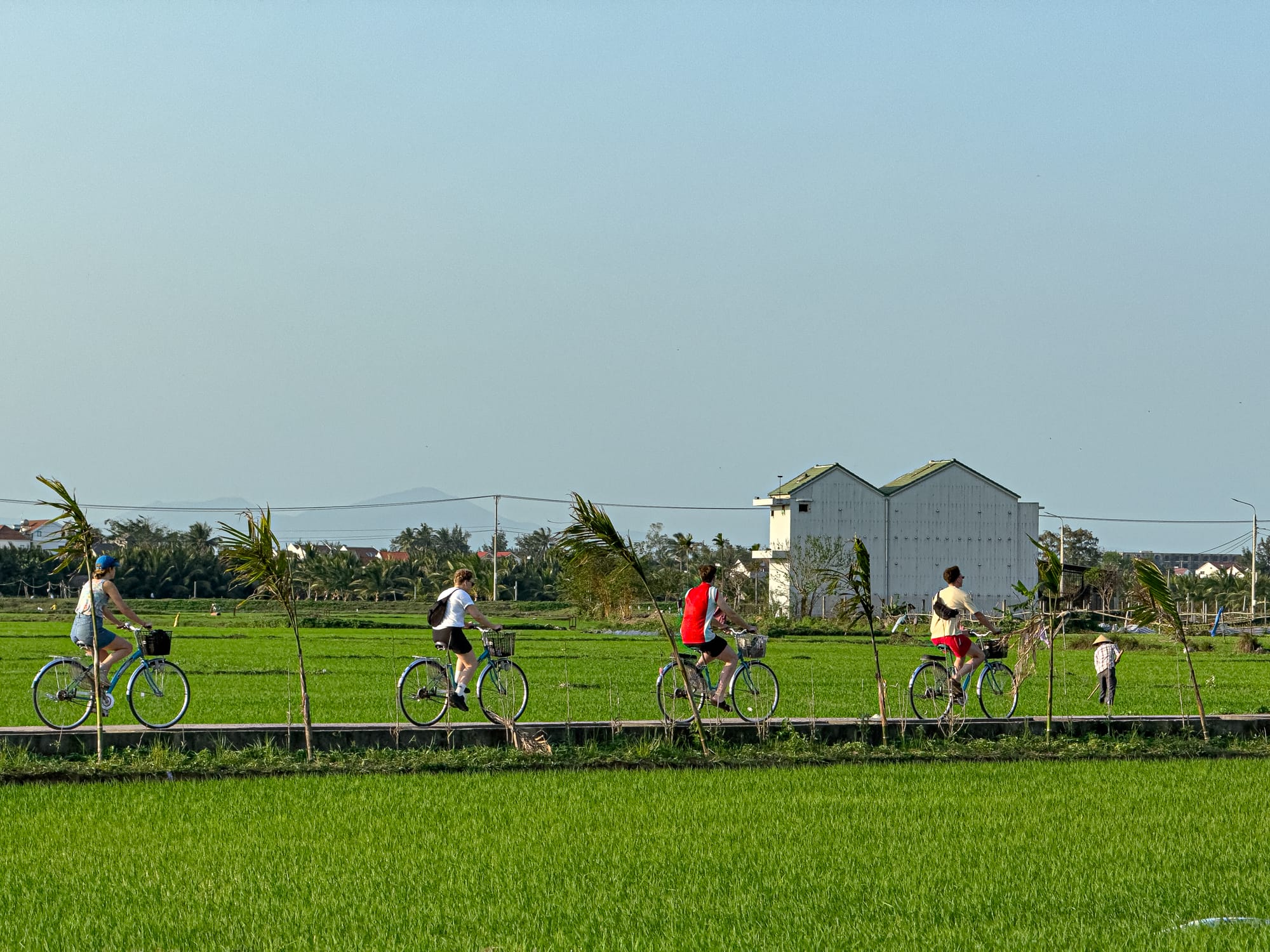
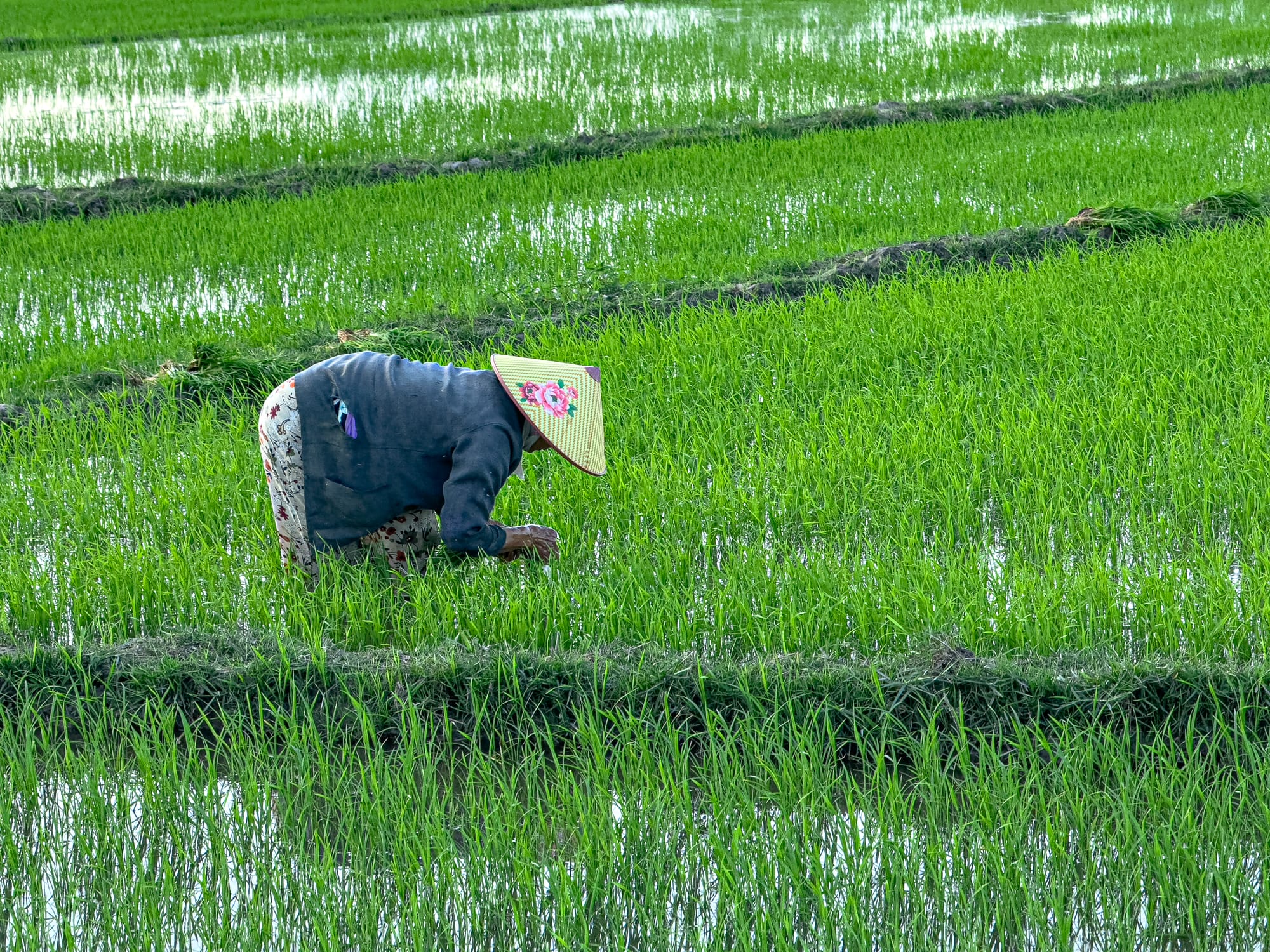
Most guesthouses and hotels provide free bikes, though rentals are also available for around 40,000 VND per day. Early mornings and late afternoons are the most comfortable times to go, with softer light and cooler air. The ride to An Bàng Beach takes about 20–25 minutes from the Old Town, and you’ll find plenty of cafés along the way if you want to stop. For nomads, it often becomes part of the daily routine—cycling through the paddies to coworking, to the beach, or just as a break from the desk.
Take a lantern making class
Hands-on with Hội An’s most iconic craft.
Lanterns are the symbol of Hội An, and taking a lantern-making workshop is one of the most engaging ways to connect with the town’s heritage. Classes are held in small family-run workshops where artisans guide you through the process—bending the bamboo frame, stretching fabric over it, and choosing colors or patterns to finish your lantern. It’s straightforward enough for beginners, and you leave with a handmade piece that folds down for easy packing.
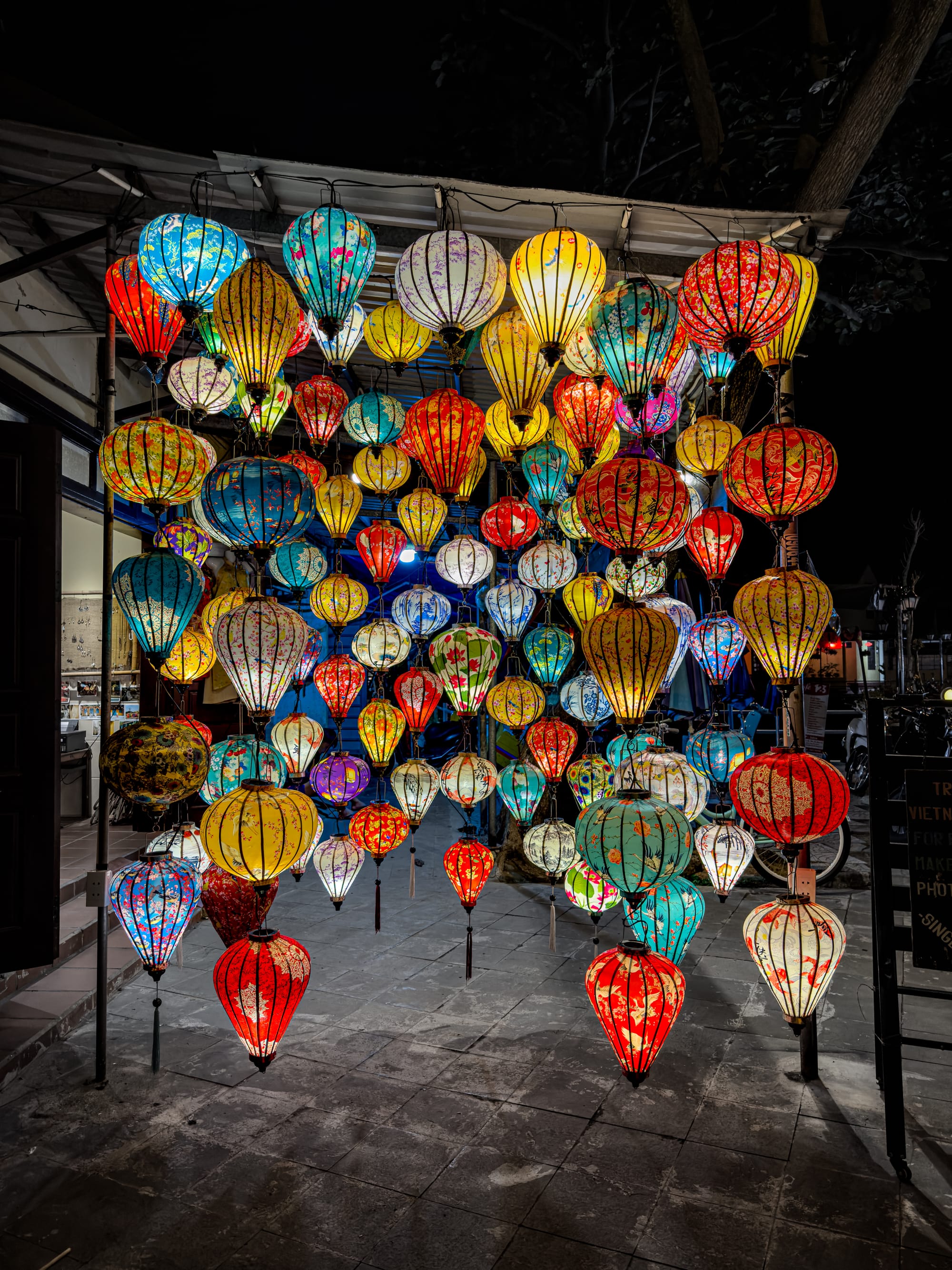
Many workshops are located right in the Old Town, though some homes just outside the center also run classes. For nomads staying longer, it’s a simple activity that gives you a deeper look into the craft traditions that keep Hội An’s culture alive.
Get tailor-made clothing
A custom tradition that defines Hội An.
Hội An is famous for its tailors, and getting clothes made here is one of the town’s signature experiences. Dozens of shops line the Old Town streets, ranging from small family-run outfits to larger, well-established studios. The process is simple: you browse designs, flip through fabrics, and work with a tailor to adjust the cut, fit, and details. Within a day or two, you can walk away with custom-made dresses, suits, or áo dài at prices far lower than in most other countries.
Turnaround times are fast—basic pieces can be ready within 24 hours, though more complex items take two or three days. Prices vary depending on the fabric and the shop, but expect to pay around $40–100 USD for a dress and $100–200 USD for a tailored suit. Reputable shops will usually offer multiple fittings to fine-tune the fit, so it’s worth building in a few extra days if you want more than one piece. Tailoring here is both practical and cultural, tying into centuries of Hội An’s trading and textile heritage. We recommend Two Ladies Tailors.
Try kitesurfing
Catch the wind on Hội An’s coast.
For those who want more than a swim, kitesurfing is one of the most exciting ways to experience Hội An’s stretch of coastline. The best conditions are at An Bàng Beach and Cửa Đại Beach, where steady onshore winds and wide sandy shores create a good setup for both beginners and experienced riders. Several small schools along the beach offer lessons, rentals, and multi-day packages if you want to learn or improve your skills.
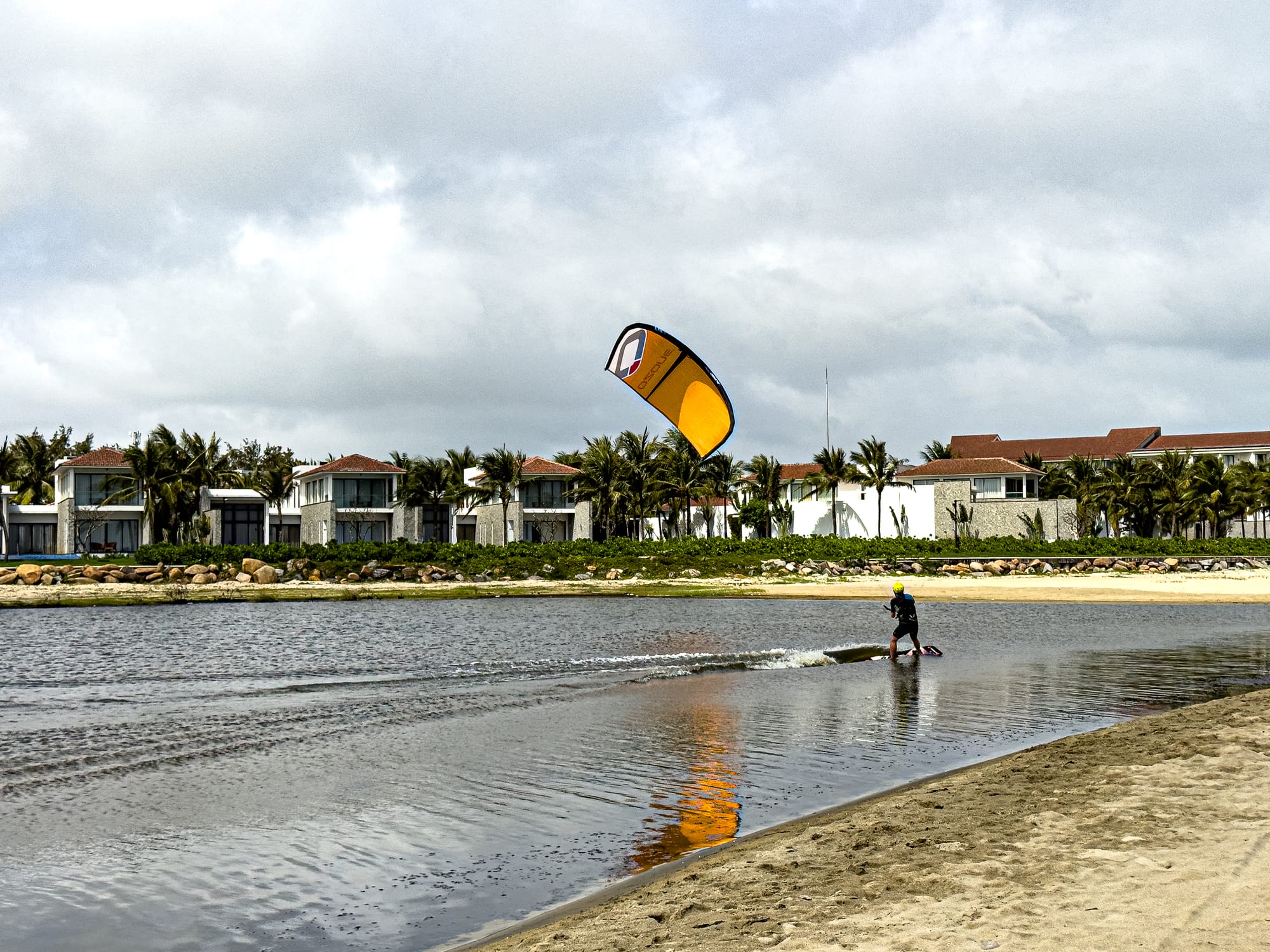
The main season runs from April to September, with peak winds in the summer months. Outside of kitesurfing, the same schools often rent stand-up paddleboards and surfboards, so you can make a full beach day of it. It’s a good balance to long workdays inland—something active and energizing just a short cycle ride from town.
Relax at An Bàng Beach
The town’s go-to stretch of sand.
An Bàng is Hội An’s most popular beach, just a 15–20 minute cycle from the Old Town through rice paddies and small villages. The sand is wide, the water is swimmable year-round, and the beach is lined with casual bars, seafood restaurants, and a handful of coworking-friendly cafés. It’s busier than the smaller coves along the coast, but the atmosphere is laid-back, with both locals and visitors gathering for morning swims, afternoon sun, and sundowners on the sand.
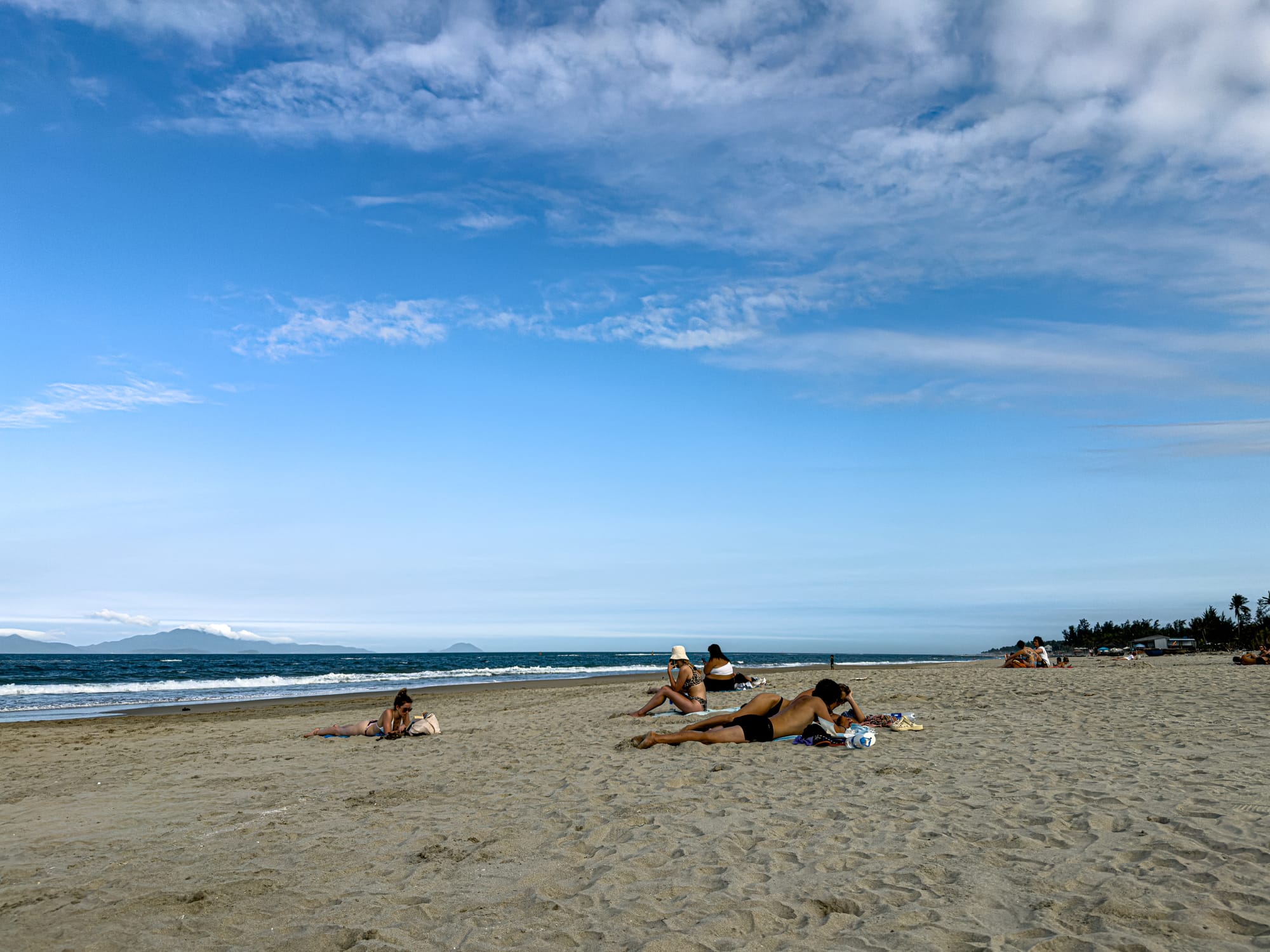
Beach chairs and umbrellas are available to rent for a small fee, and the north end tends to be quieter if you want more space. Weekends can be crowded, especially in high season, so weekdays are often better for swimming or working at a beachfront café. Whether you’re here to unwind after a few hours of work or to spend a full day by the sea, An Bàng is the easiest beach escape from Hội An.
Get a massage at Cam Spa
A restorative blend of Thai and hot stone.
After days of cycling through rice fields or exploring Hội An’s Old Town, a session at Cám Spa is an ideal reset. Their signature two-hour massage combines Thai techniques, coconut oil, and hot stones to release tension and restore energy. The treatment is designed to balance deep pressure with calming warmth, leaving you both relaxed and recharged.
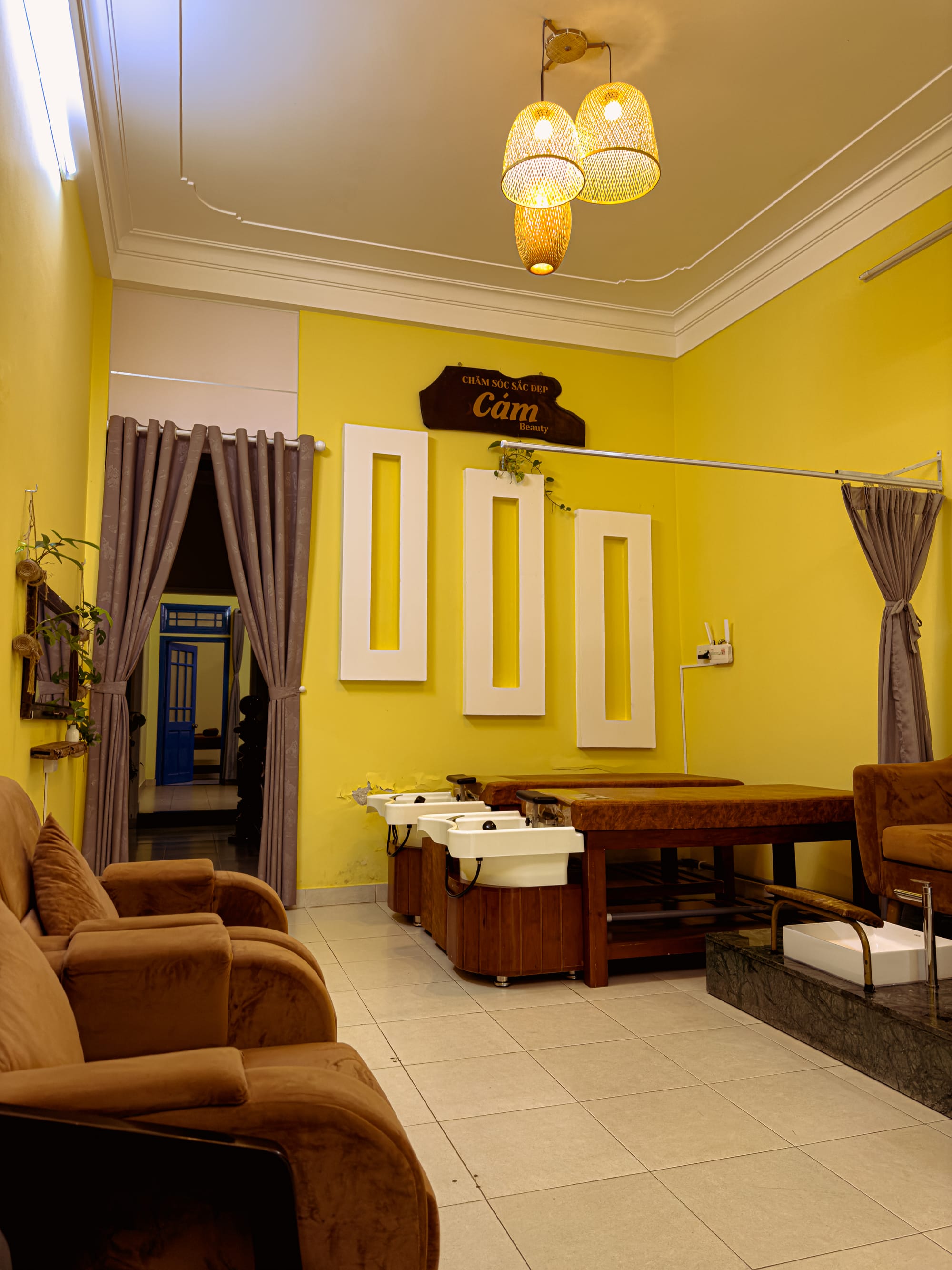
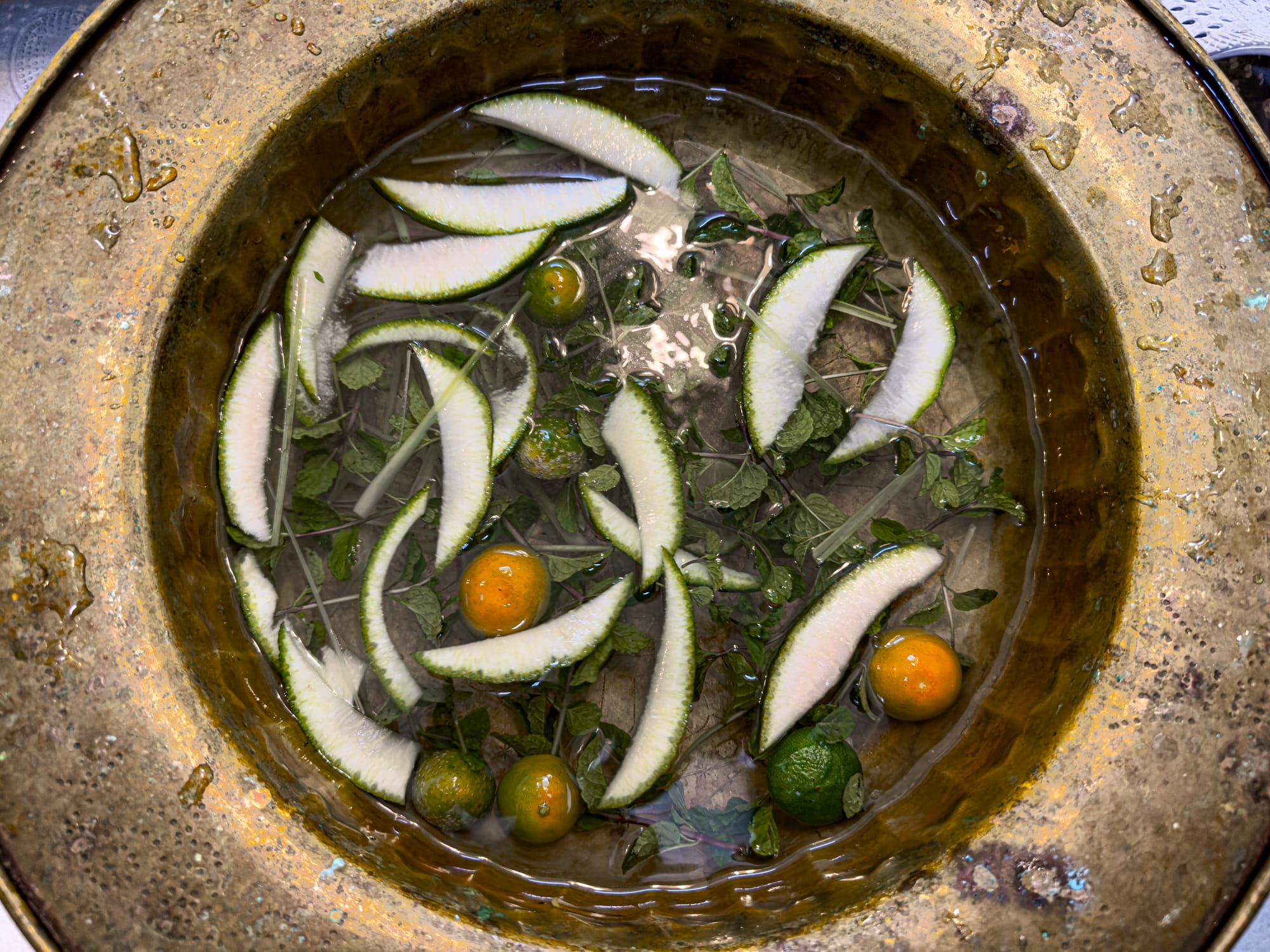
The setting itself adds to the experience: soft lighting, quiet rooms, and attentive care that feels unhurried from start to finish. Whether you book it as a weekly ritual or a one-time treat during your stay, Cám Spa is one of the most reliable places in town to unwind and bring your body back into rhythm.
Craft villages
Tra Que Vegetable Village
A working farm at the edge of town.
Just a short cycle north of Hội An, Trà Quế Vegetable Village is a patch of countryside where families have been farming herbs and vegetables for generations. Instead of chemical fertilizers, the soil is enriched with riverweed collected from nearby lakes, giving the produce its distinct flavor. Walking through the gardens, you’ll see rows of mint, basil, coriander, and morning glory being watered with the traditional twin-can system balanced on bamboo poles. It’s both photogenic and functional—farming as a daily craft.
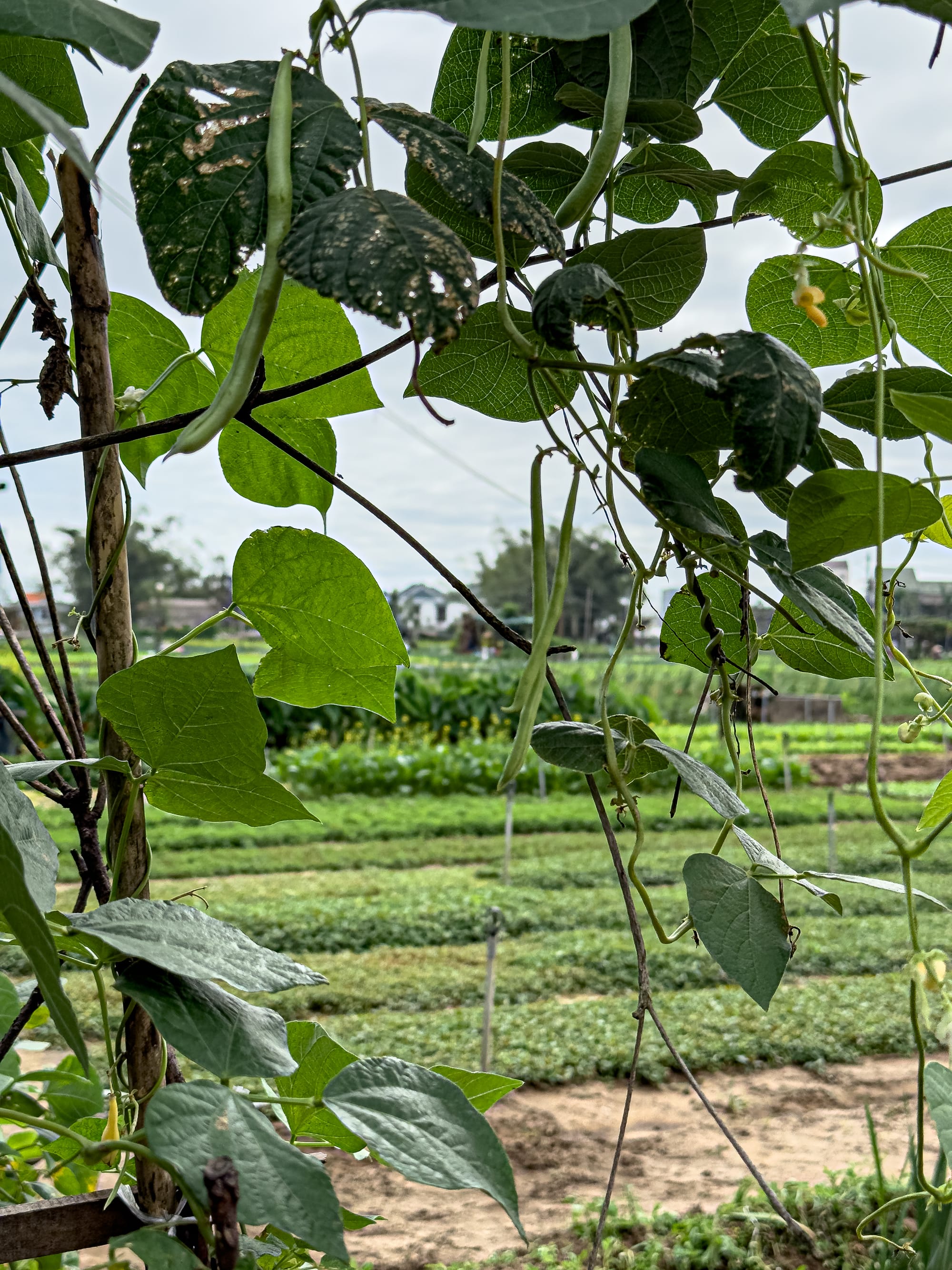
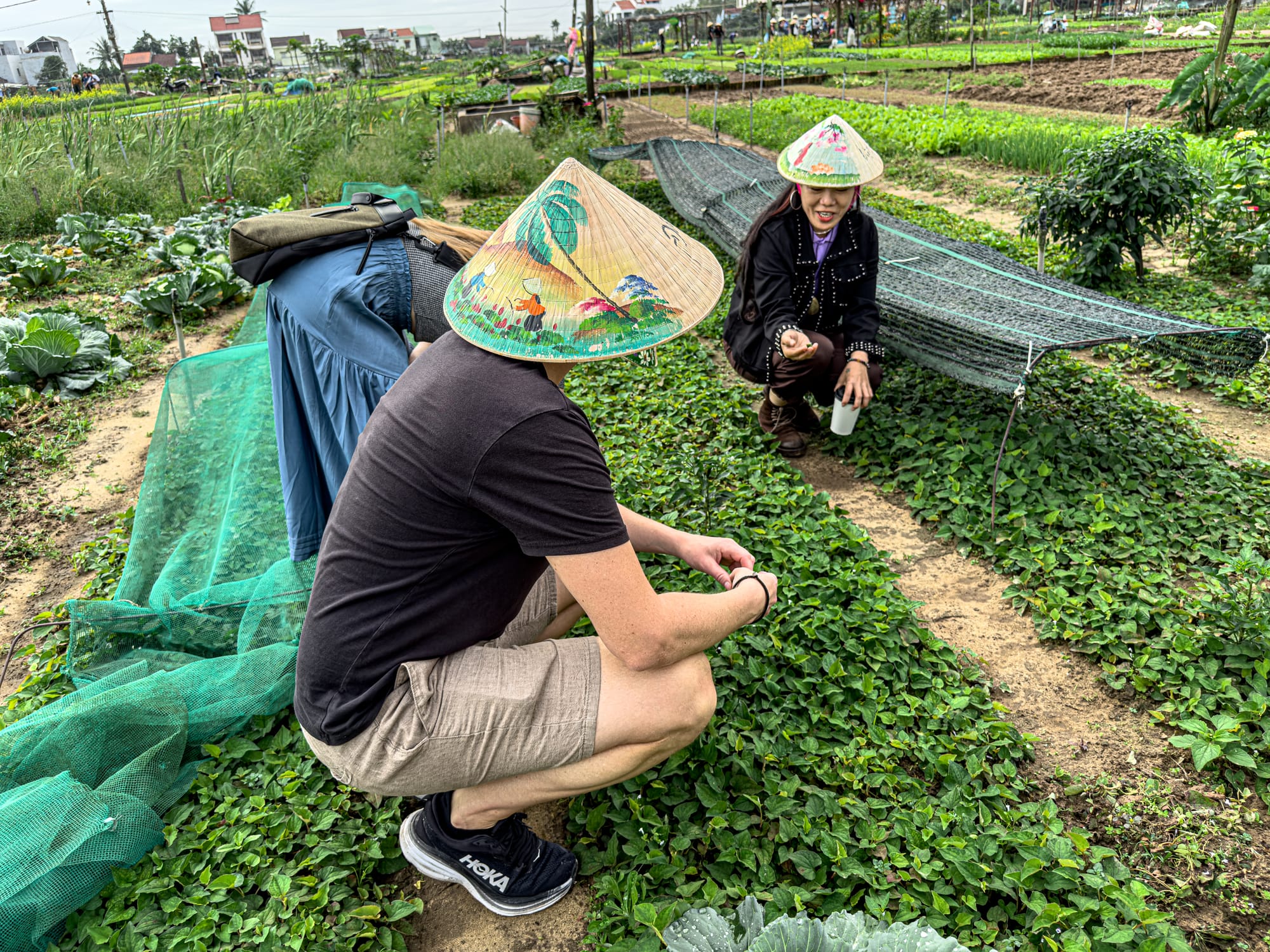
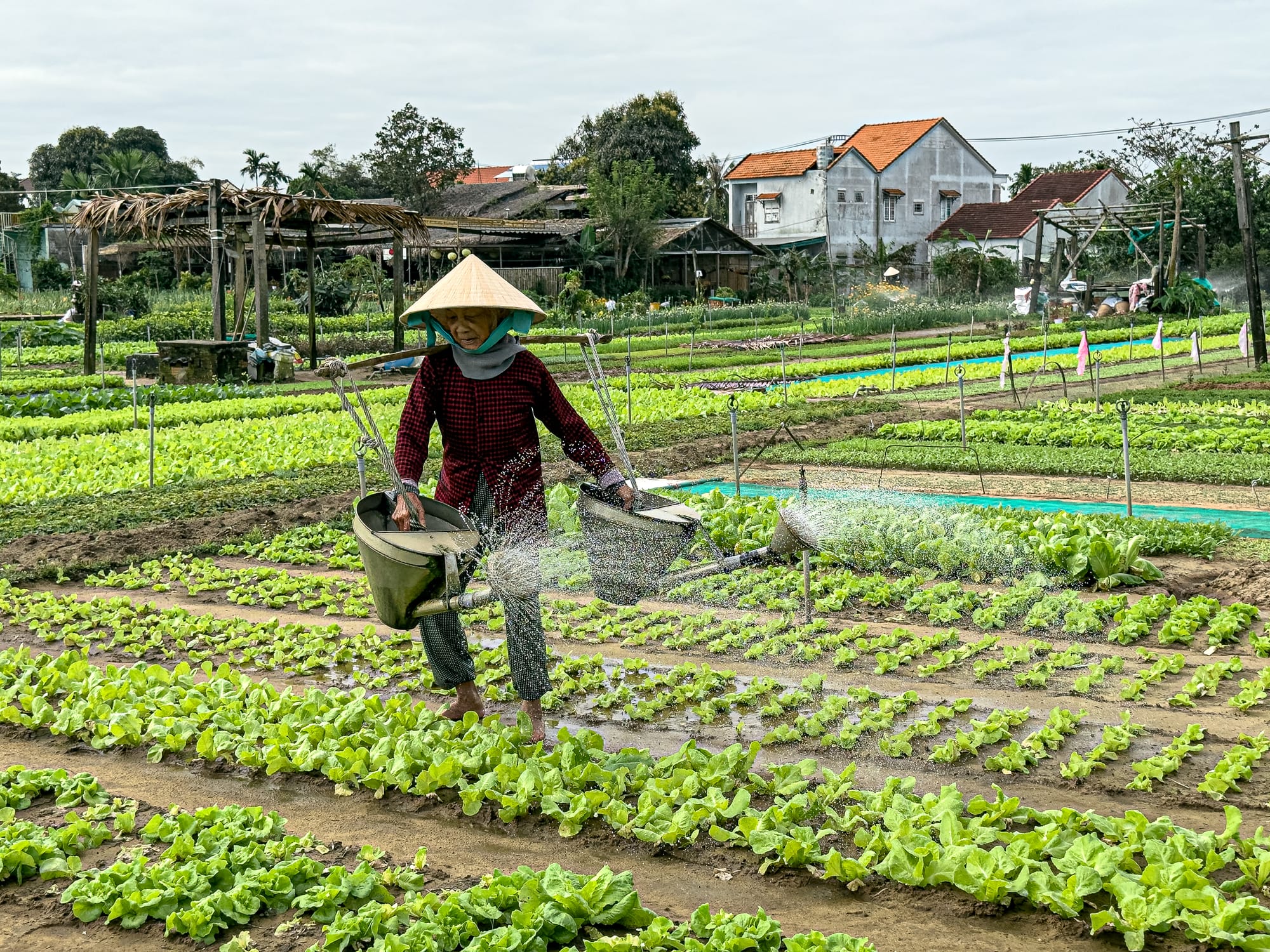
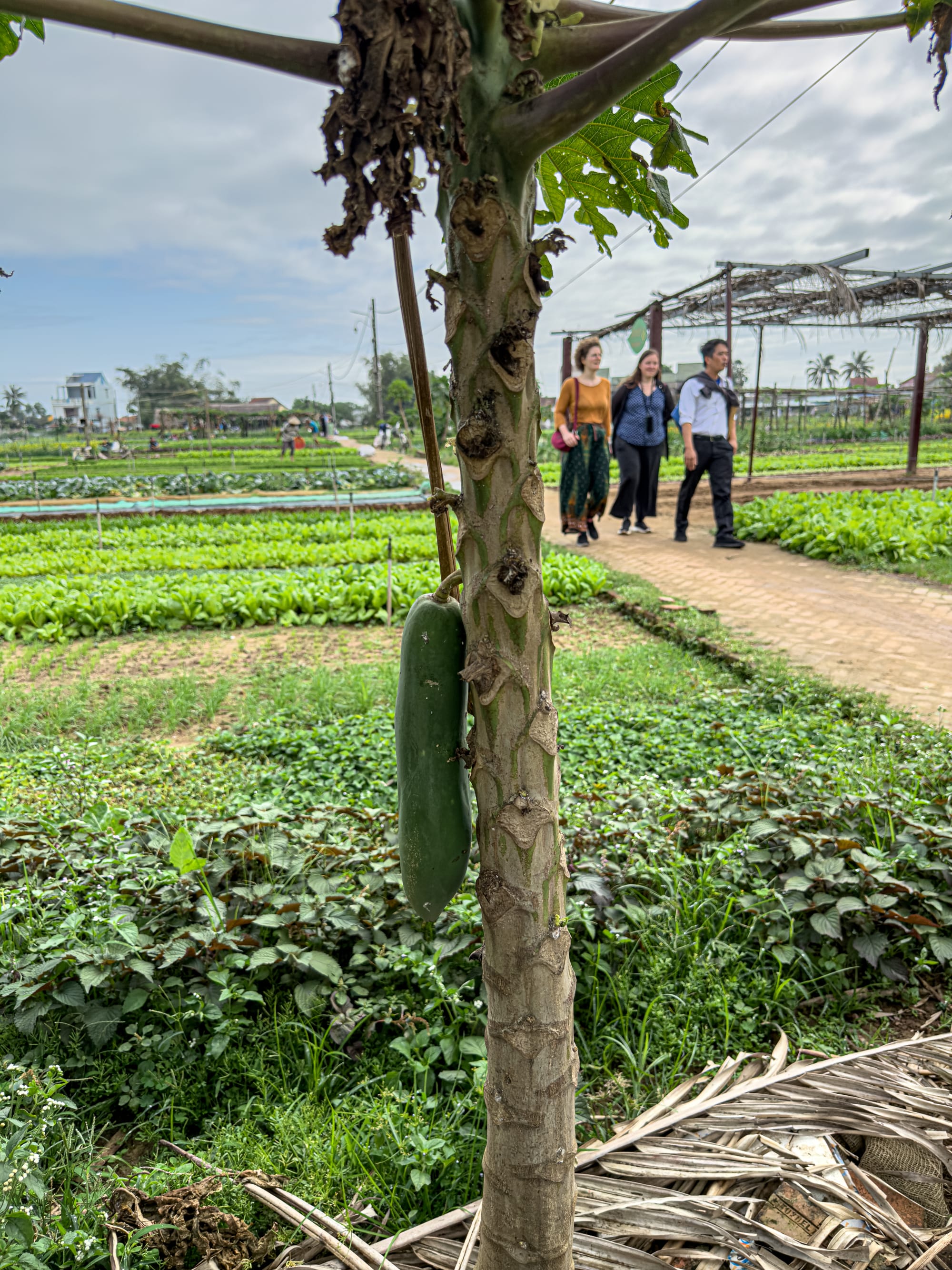
Visitors can join short tours or cooking classes that begin in the village, often starting with a hands-on farming demo before moving into a kitchen to prepare dishes with freshly harvested herbs. Even if you don’t book an activity, it’s worth cycling out just to see the rhythms of local agriculture up close. Early mornings are the best time to visit, when the fields are alive with work and the light is soft across the paddies.
Thanh Hà Pottery Village
Centuries of clay craft on the river.
Located just west of Hội An along the Thu Bồn River, Thanh Hà Pottery Village has been producing clay goods for over 500 years. Families here still shape and fire pottery much as their ancestors did, supplying bowls, jars, and tiles to the region. Walking through the village, you’ll see open-air workshops where clay is thrown on kick wheels, molded by hand, and decorated before being fired in traditional brick kilns. It’s a working village, not just a display, and the atmosphere feels authentic and grounded in daily life.
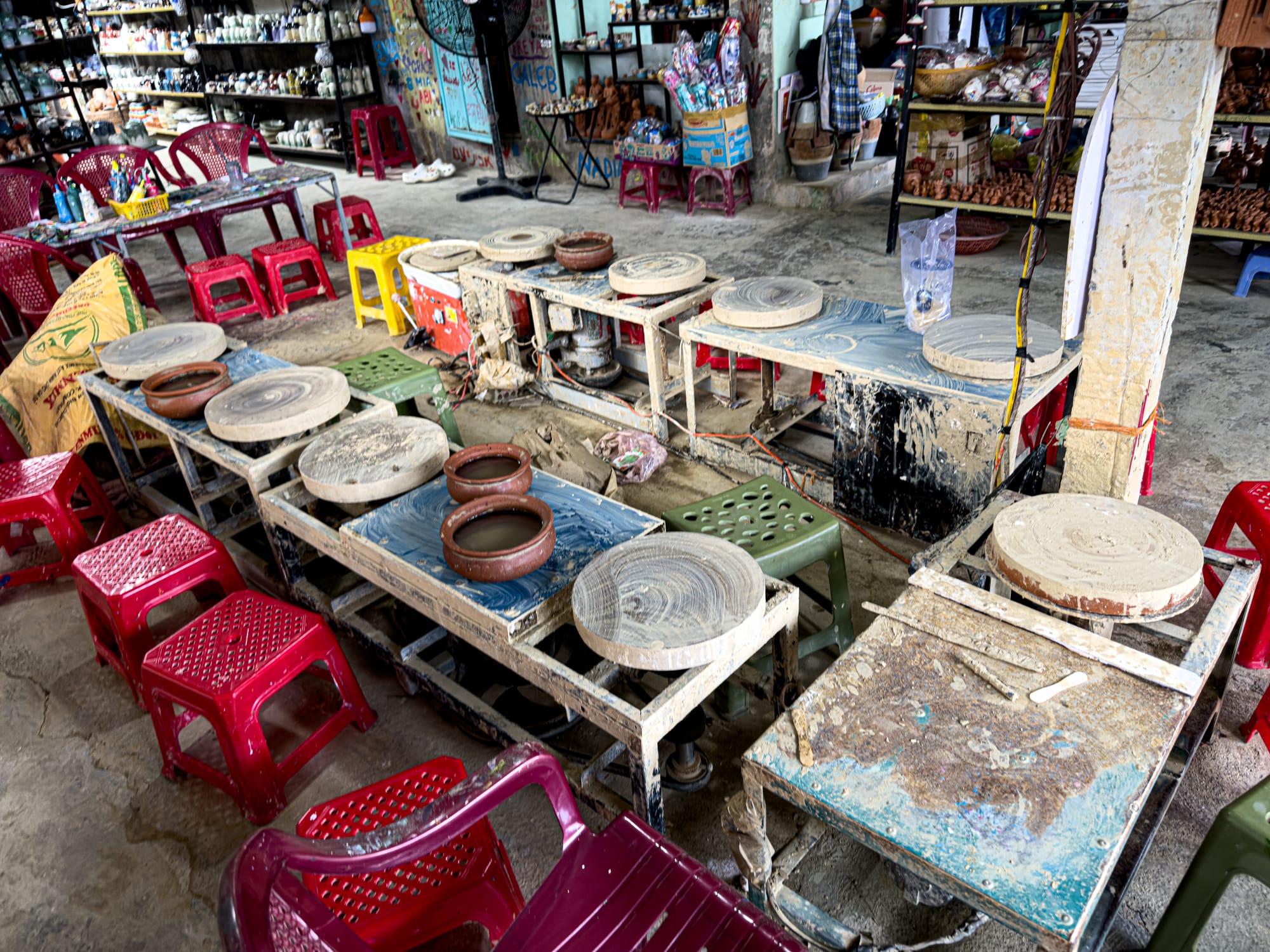
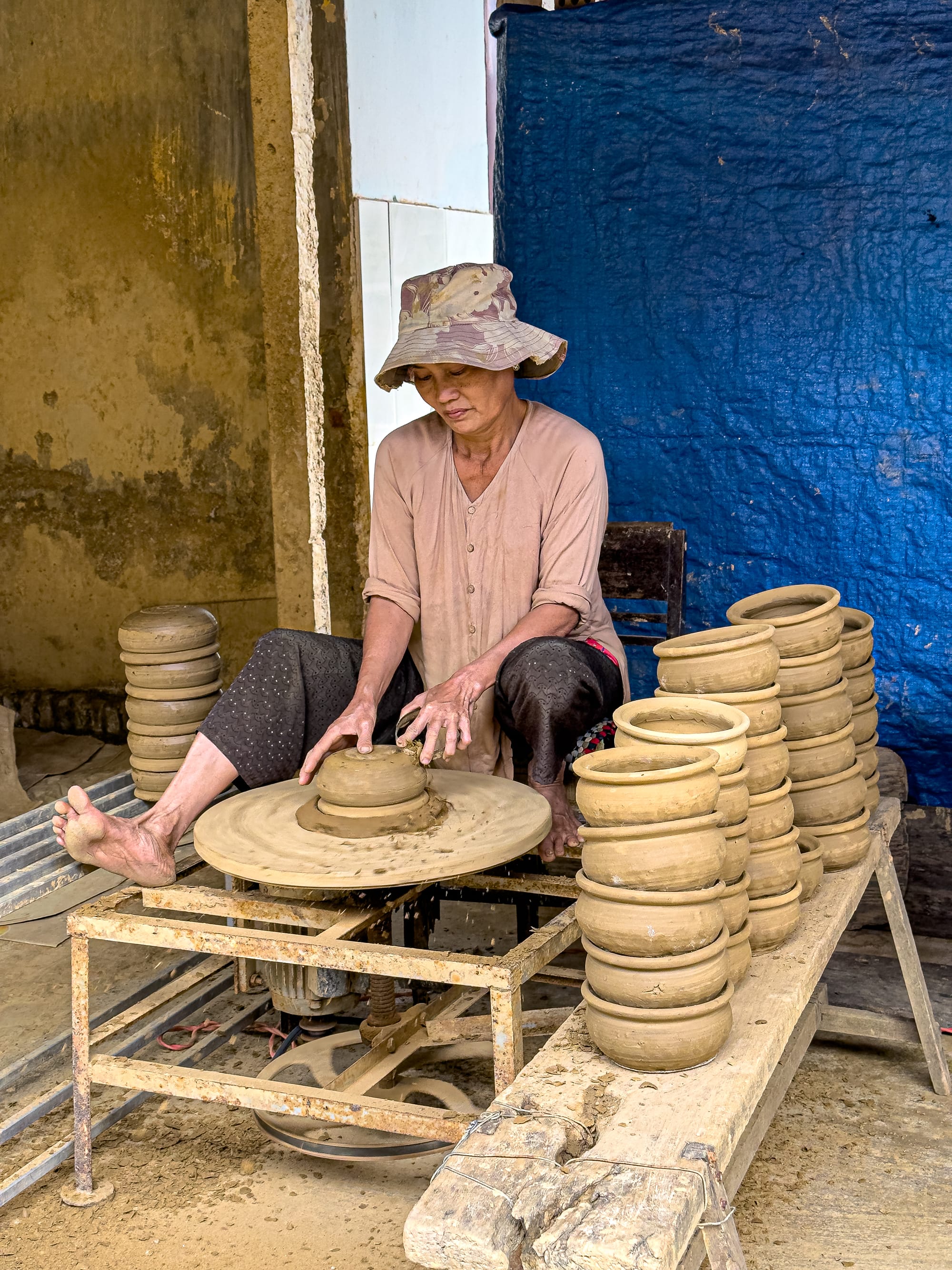
For visitors, there are opportunities to try your hand at the wheel, make small figurines, or simply watch the process unfold. Entry includes access to the workshops, a small museum, and the chance to buy ceramics directly from the artisans. The best time to go is mid-morning, when workshops are active and the air is cooler. It’s an easy half-day trip from Hội An, best combined with a riverside cycle or boat ride back into town.
Vegan cooking classes and cuisine
Chickpea Eatery’s vegan cooking class
Plant-based takes on regional classics.
Chickpea Eatery has built a reputation as one of Hội An’s best vegan restaurants, and their cooking class is a chance to learn how they adapt traditional dishes without losing flavor. The class begins with a guided visit to a local market, where you’ll taste tropical fruits, smell herbs like Vietnamese mint and lemongrass, and pick up ingredients for the day. Back at the restaurant, each participant has their own cooking station, so you prepare every dish from start to finish under the guidance of the chefs.
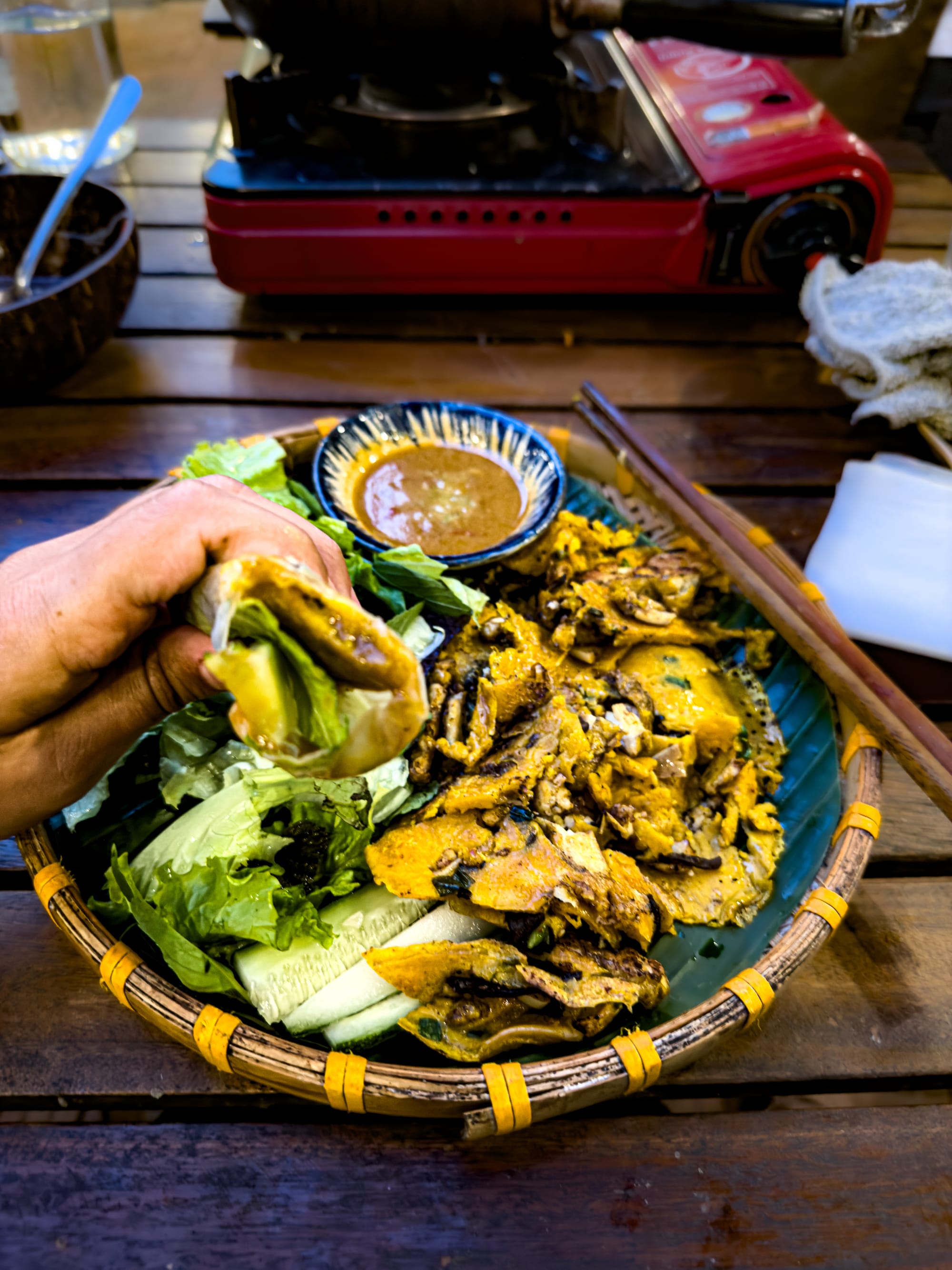
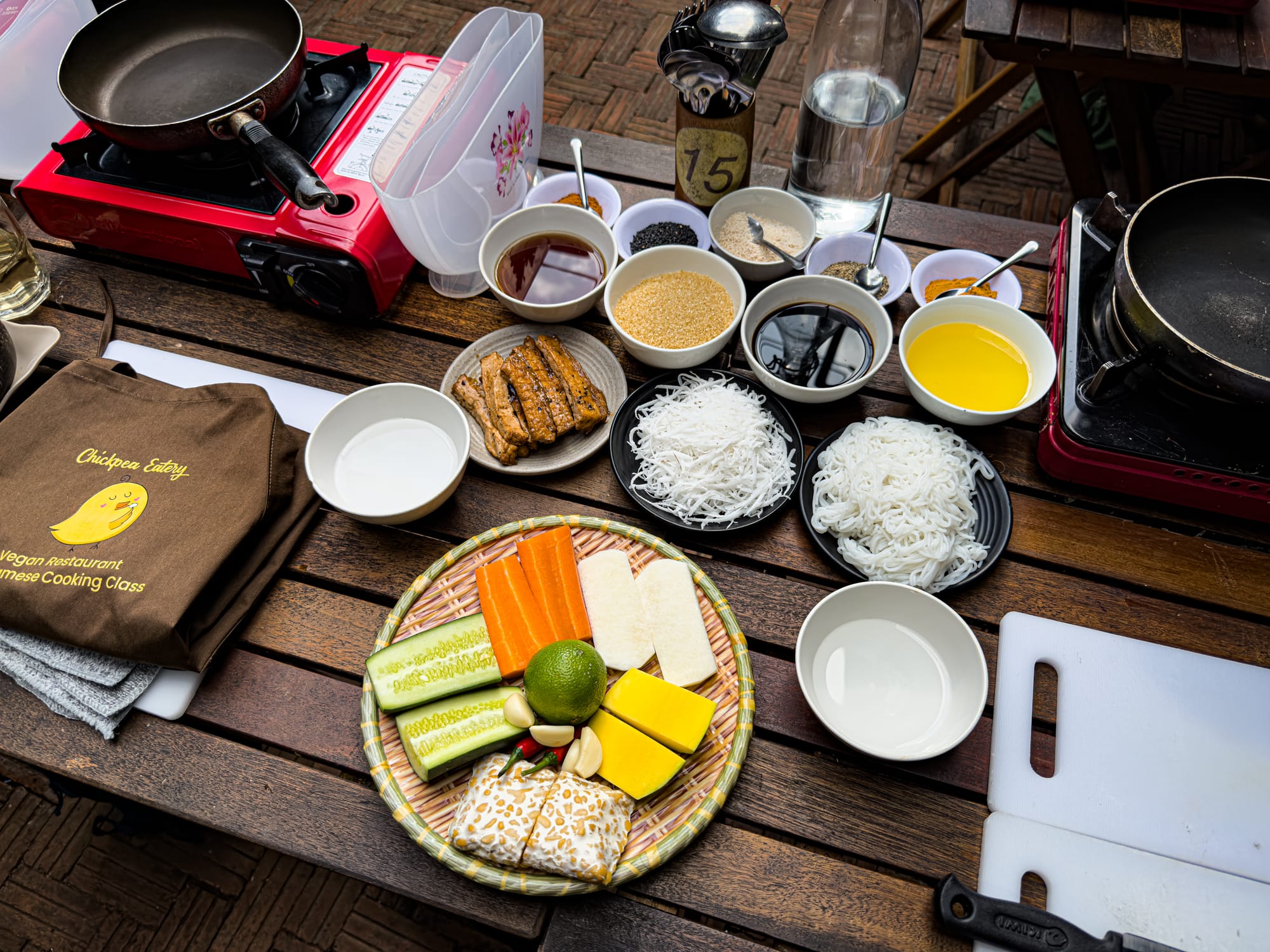
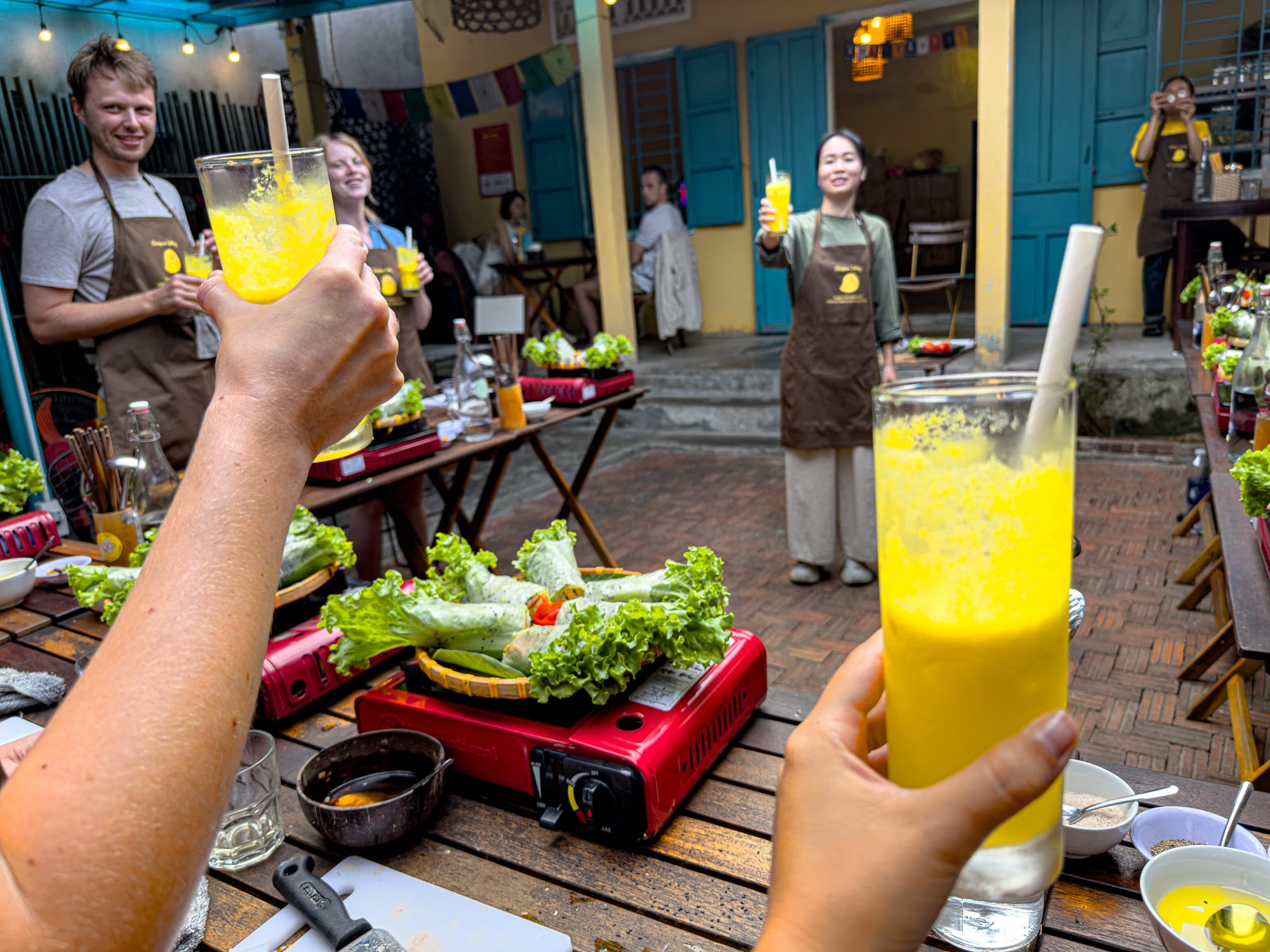
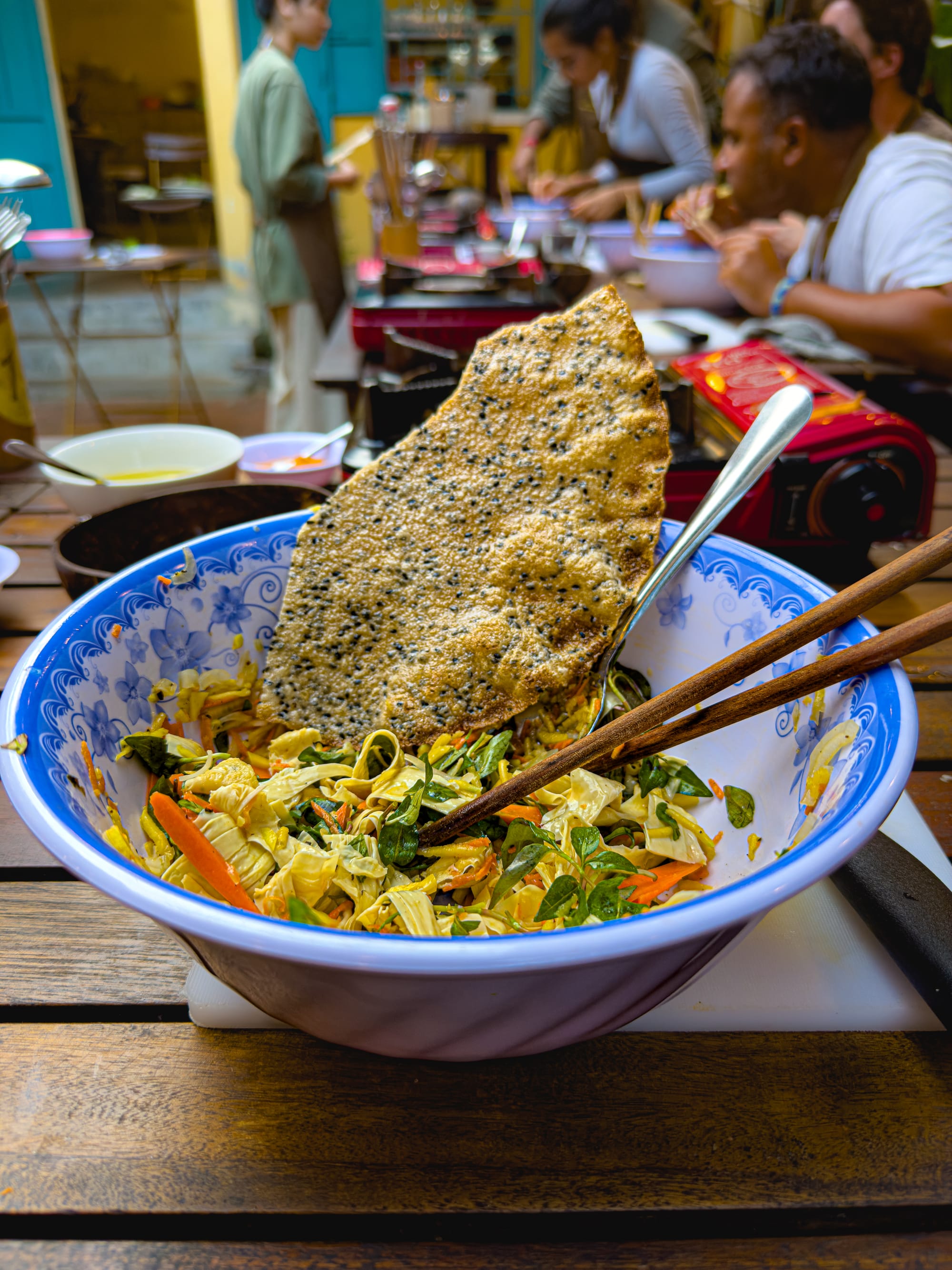
The menu changes seasonally, but often includes staples like bánh xèo (crispy rice pancakes), vegan “chicken” rice, and fresh spring rolls. Along the way you’ll learn about the balance of flavors—sweet, salty, sour, spicy, and bitter—that define Vietnamese cuisine. Classes are small, usually no more than 8–10 people, which makes it easy to ask questions and fine-tune your dishes. At the end, everyone sits down to eat together, with leftovers packed up to take home.
Rau Oi Eatery’s vegan cooking class
Farm-to-table learning in Hội An’s countryside.
Rau Ởi Eatery runs one of Hội An’s most immersive vegan cooking classes, combining a visit to Trà Quế Vegetable Village with hands-on cooking at their riverside restaurant. The experience begins in the fields, where you meet farmers, learn how the soil is enriched with seaweed, and see how herbs like basil and coriander are grown and harvested. From there, the group heads to a local market to explore produce stalls and taste tropical fruits before gathering the final ingredients for the meal.
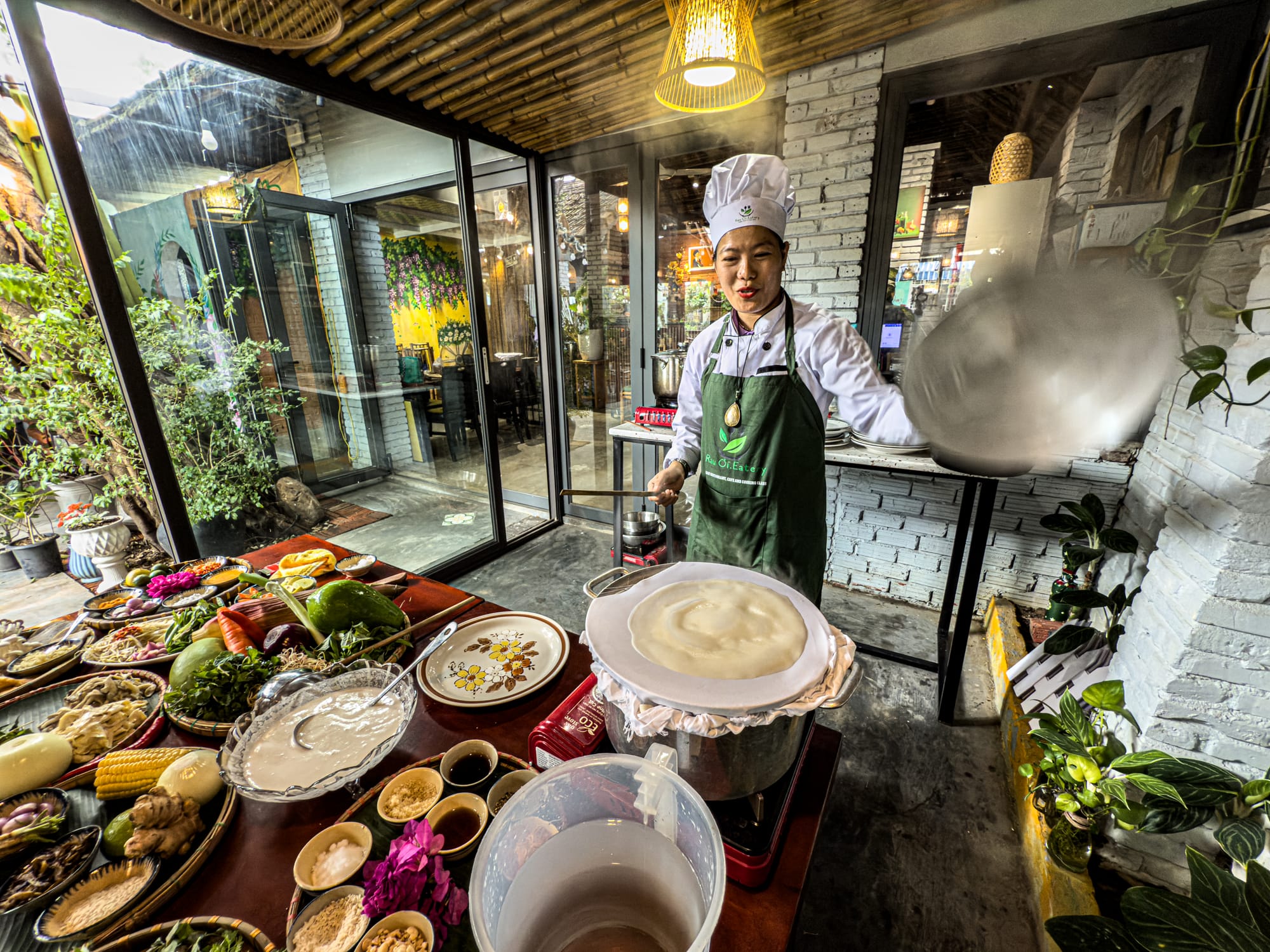
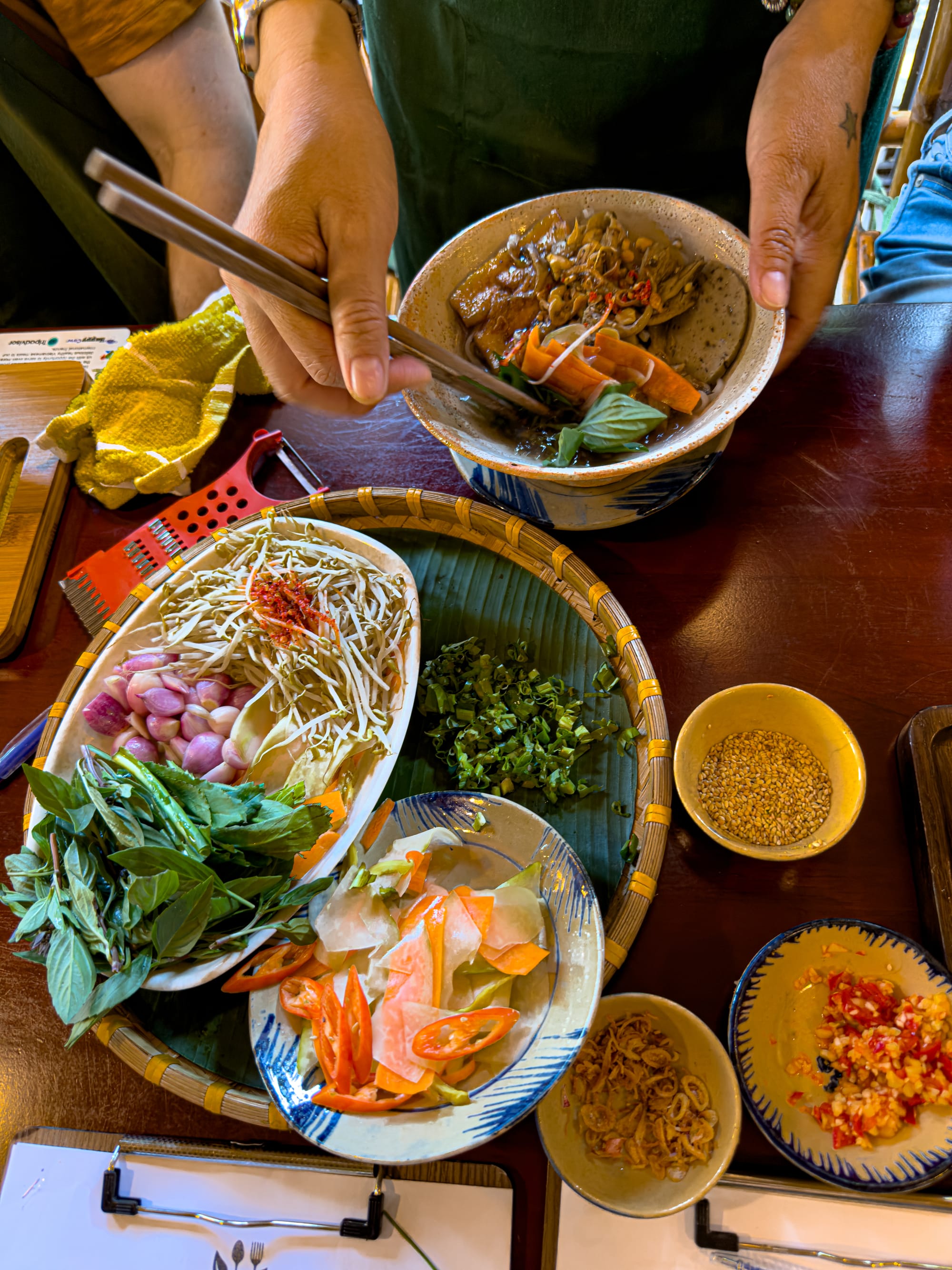
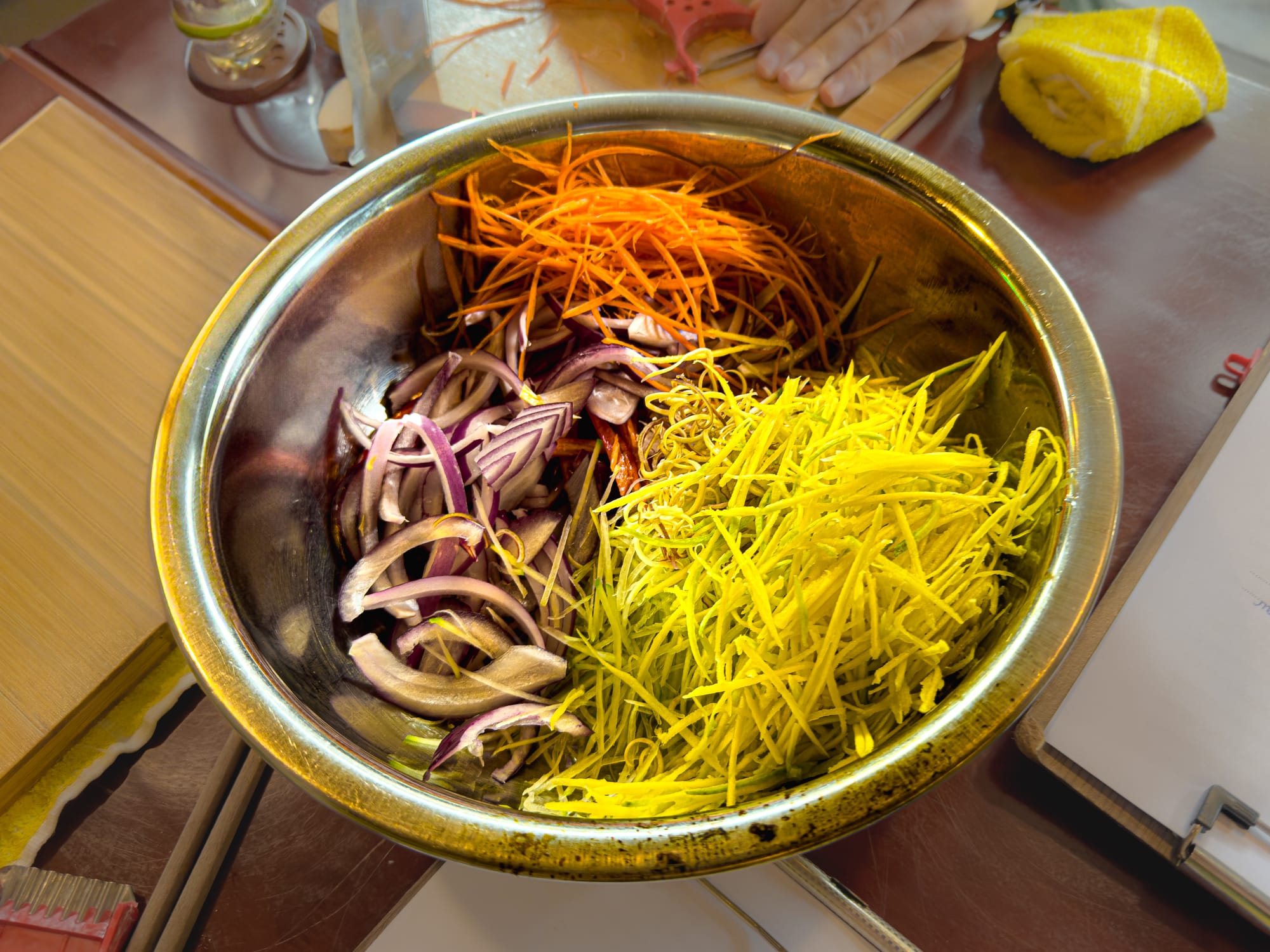
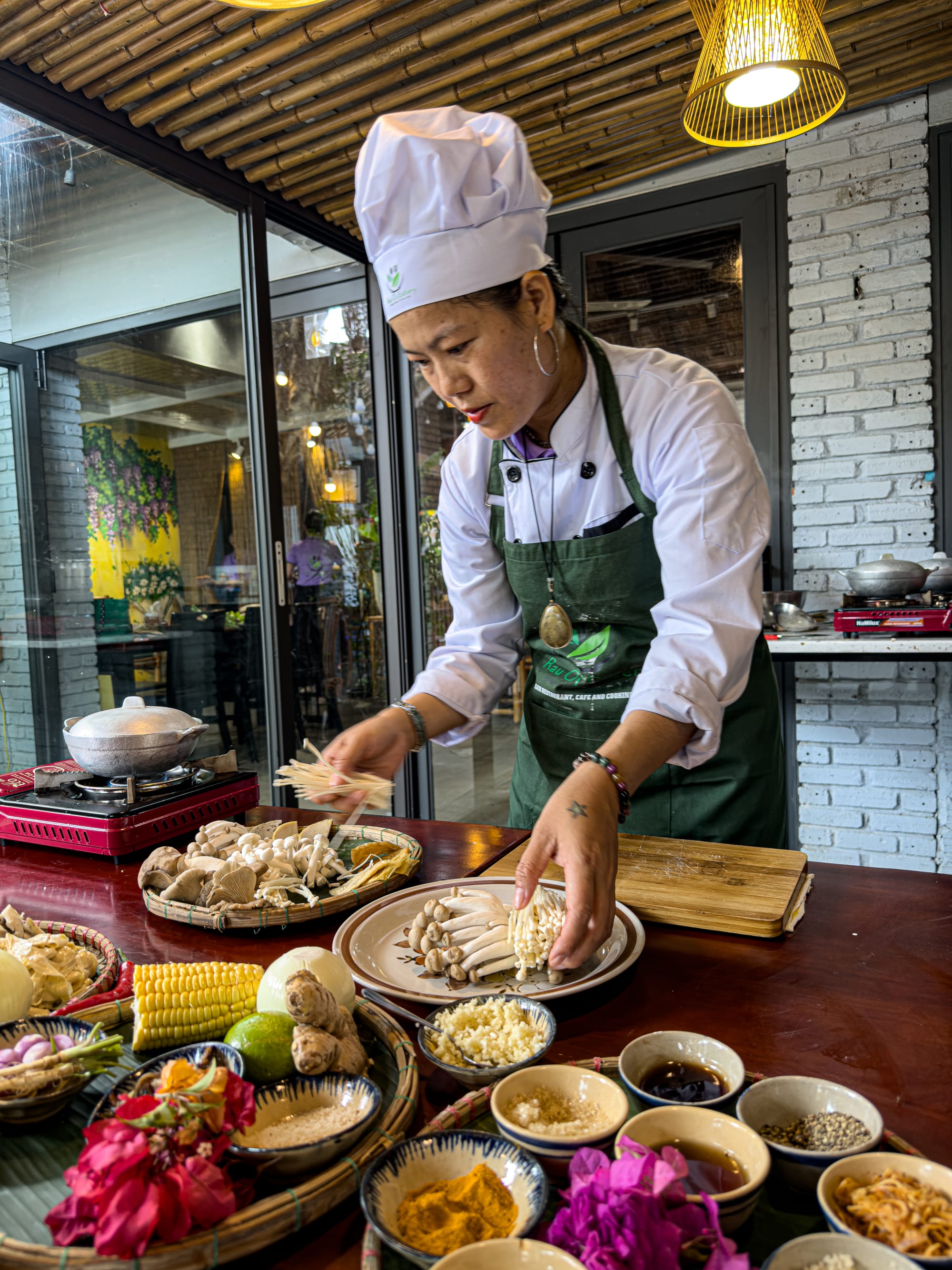
Back at Rau Ởi, the cooking session focuses on vegan versions of local dishes such as banana blossom salad, Hội An-style “chicken” rice, fresh spring rolls made with rice paper prepared from scratch, and a slow-simmered phở with a deeply flavored broth. The class is led by Chef Vang, whose focus is on keeping authentic flavors while making them fully plant-based. It’s social, thorough, and ends with a shared meal and tour of restaurant’s garden. For those interested in both food and local farming traditions, this class is an excellent way to spend a day outside the Old Town.
Vegan food in Hội An
One of Southeast Asia’s best plant-based scenes.
For a town of its size, Hội An has an exceptional vegan food culture. Many local dishes are naturally plant-based or easily adapted, and dozens of cafés and restaurants across town specialize in vegan menus. Staples like cao lầu, mì quảng, and bánh mì are reimagined with mushrooms, tofu, and jackfruit, while creative takes on international favorites—smoothie bowls, curries, and vegan pizzas—are easy to find. The abundance of fresh herbs from nearby Trà Quế and surrounding farms keeps everything vibrant and flavorful.
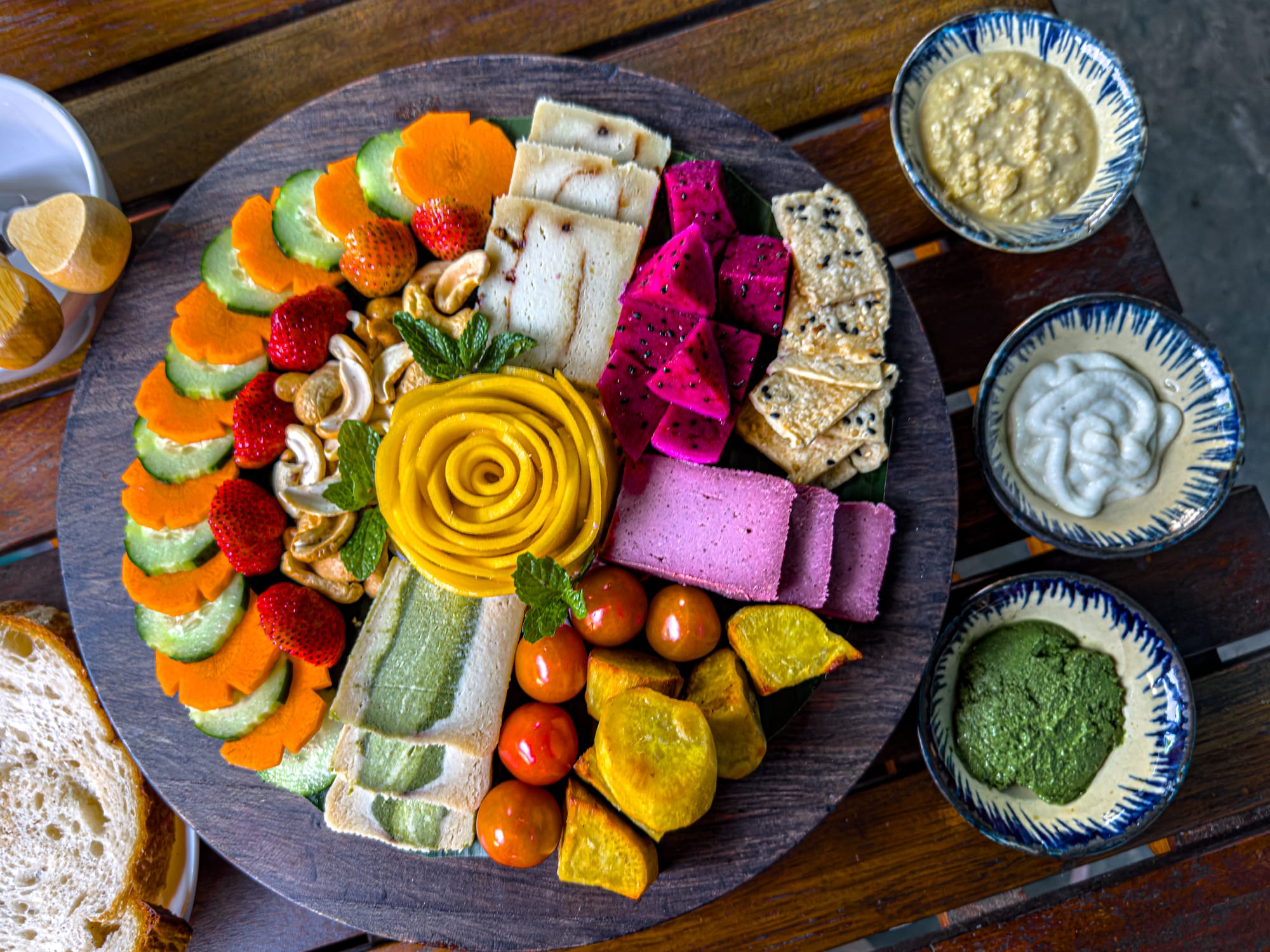
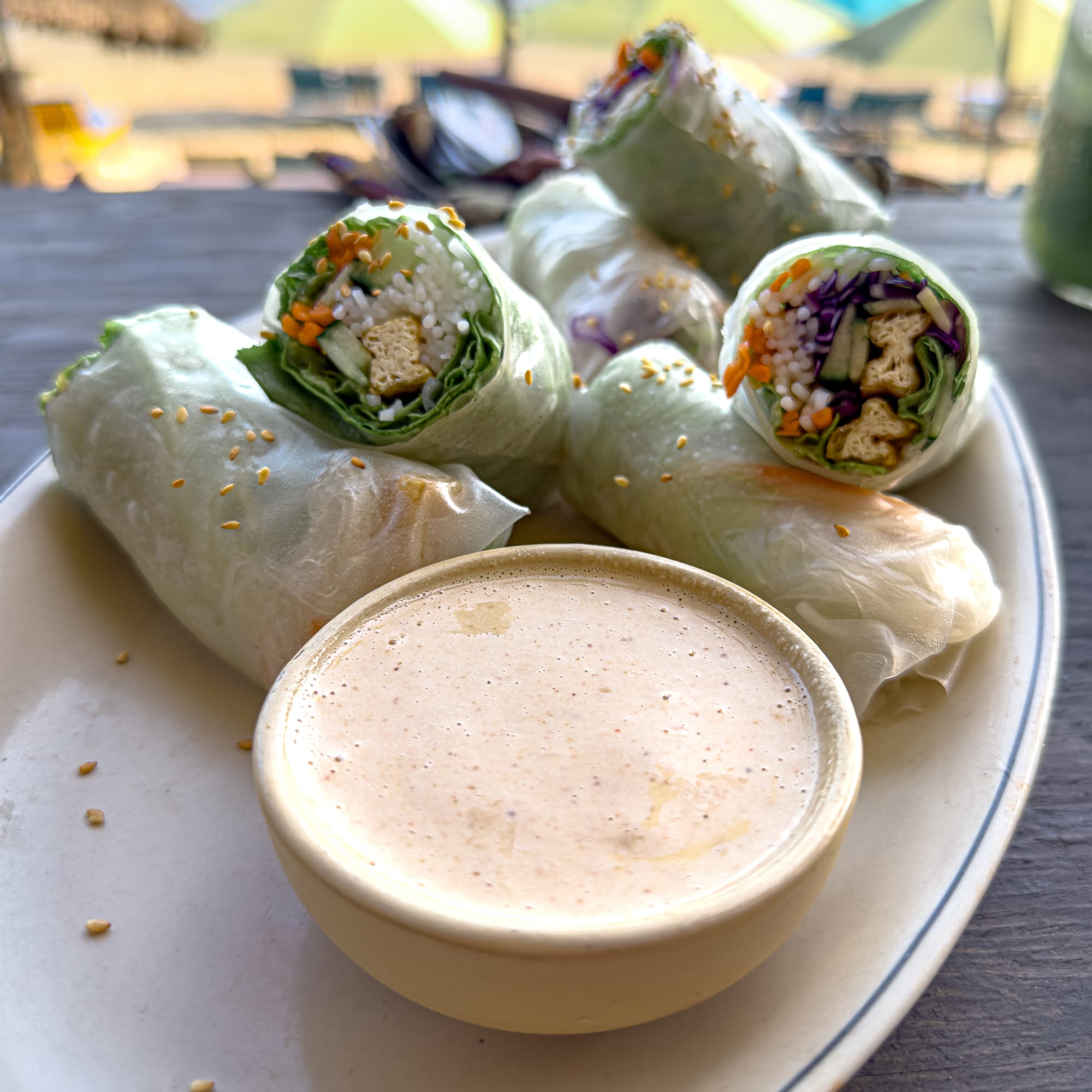
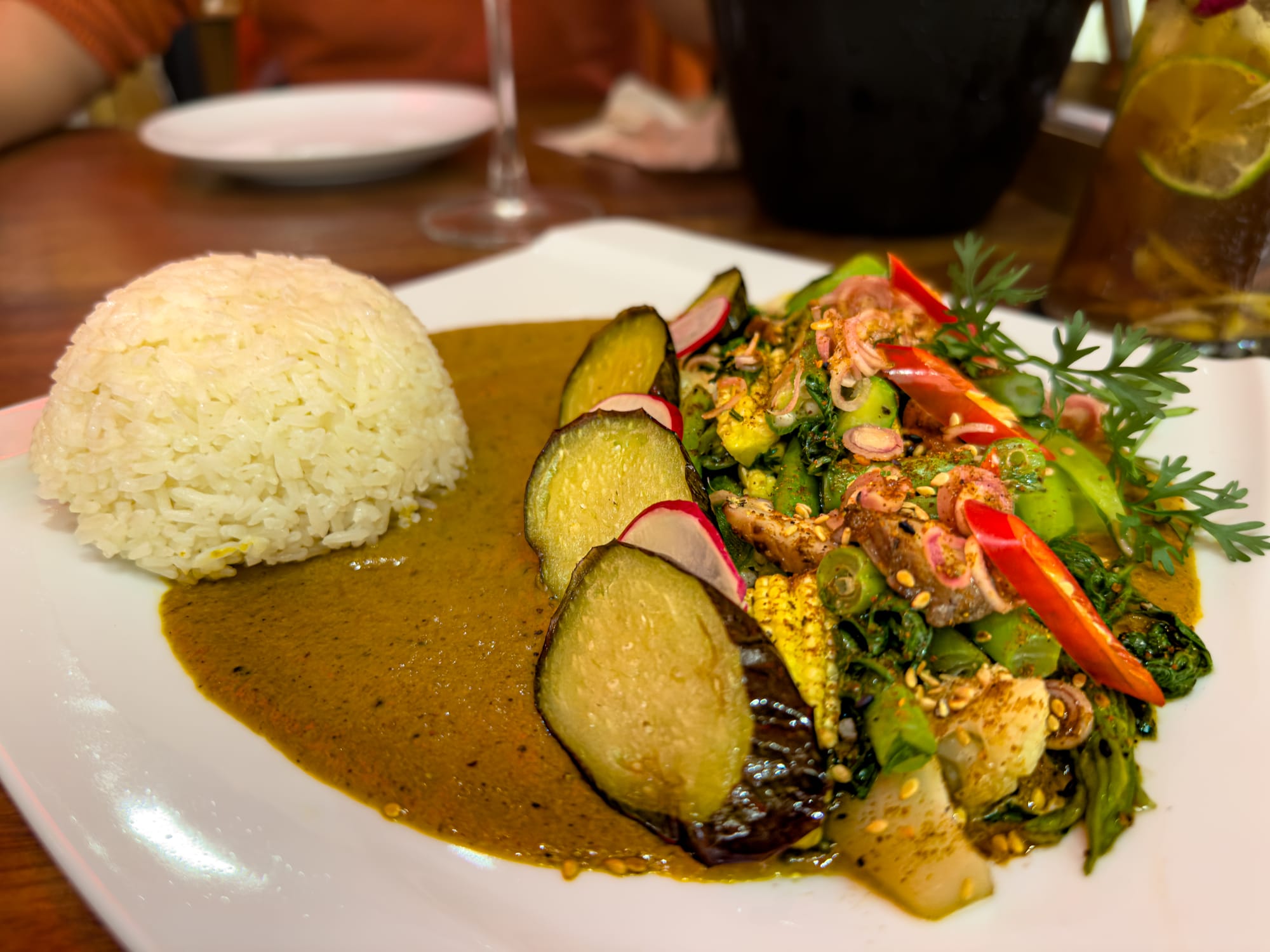
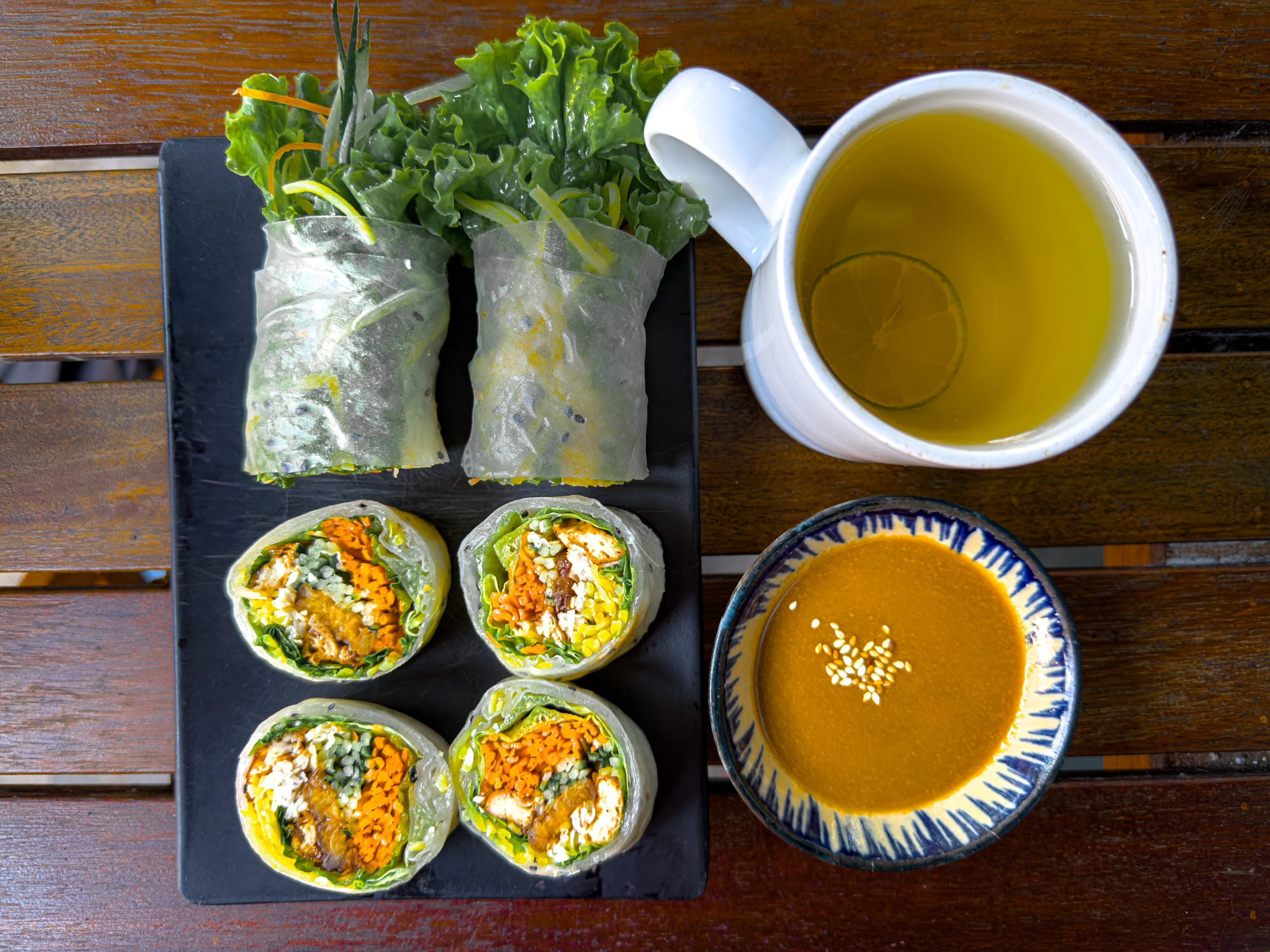
For vegans, the variety means you can rotate between comfort food and local dishes without running out of options—even if you’re staying for months.
Day or weekend trips
My Son Sanctuary
Ancient temples in a jungle valley.
About an hour’s drive from Hội An, Mỹ Sơn Sanctuary is a cluster of Hindu temples built by the Champa Kingdom between the 4th and 13th centuries. Once an important religious and political center, the site now consists of red-brick towers and stone carvings scattered across a lush valley, many partially reclaimed by vegetation. It’s one of Vietnam’s most significant archaeological sites and a designated UNESCO World Heritage site.
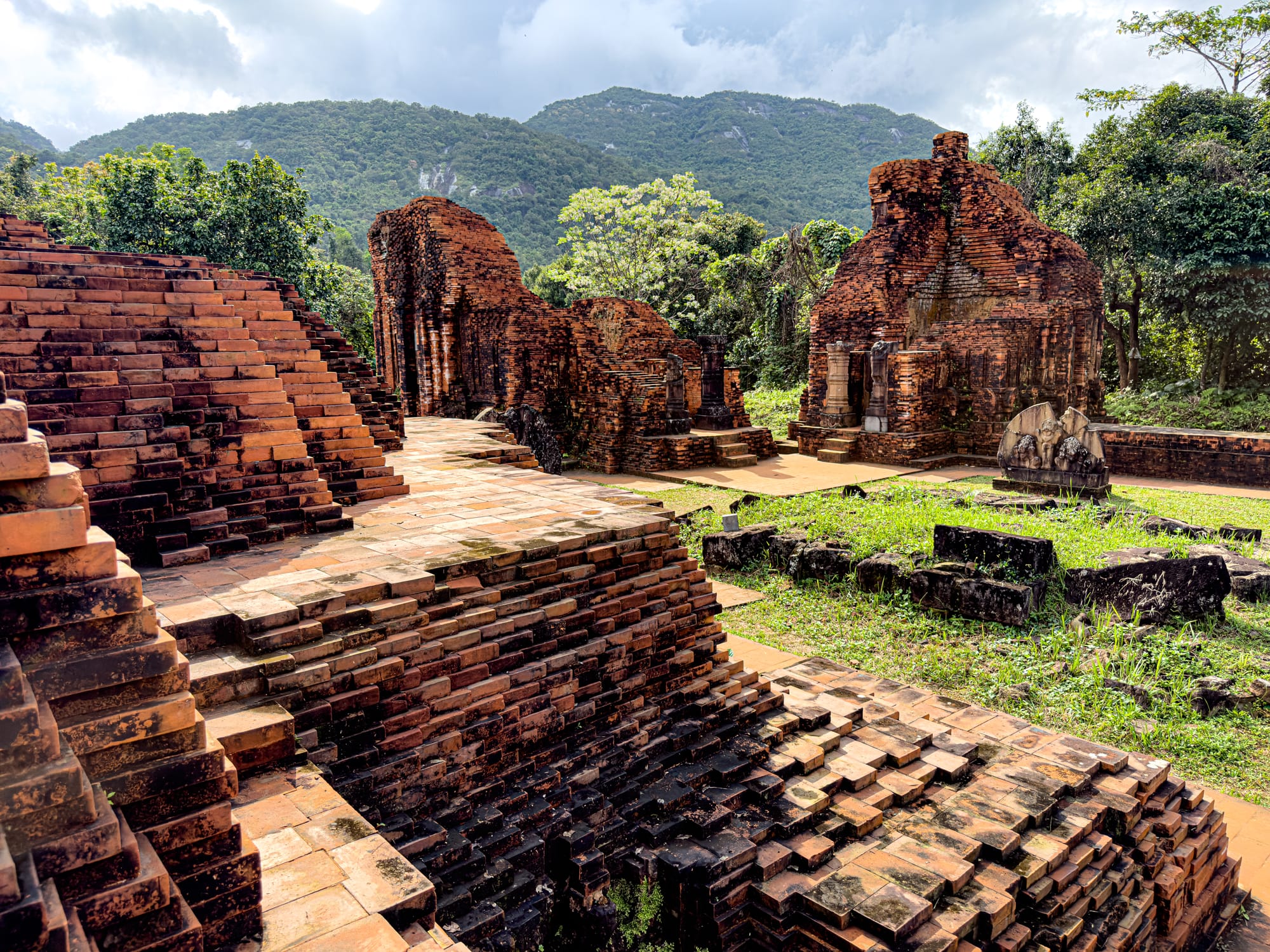
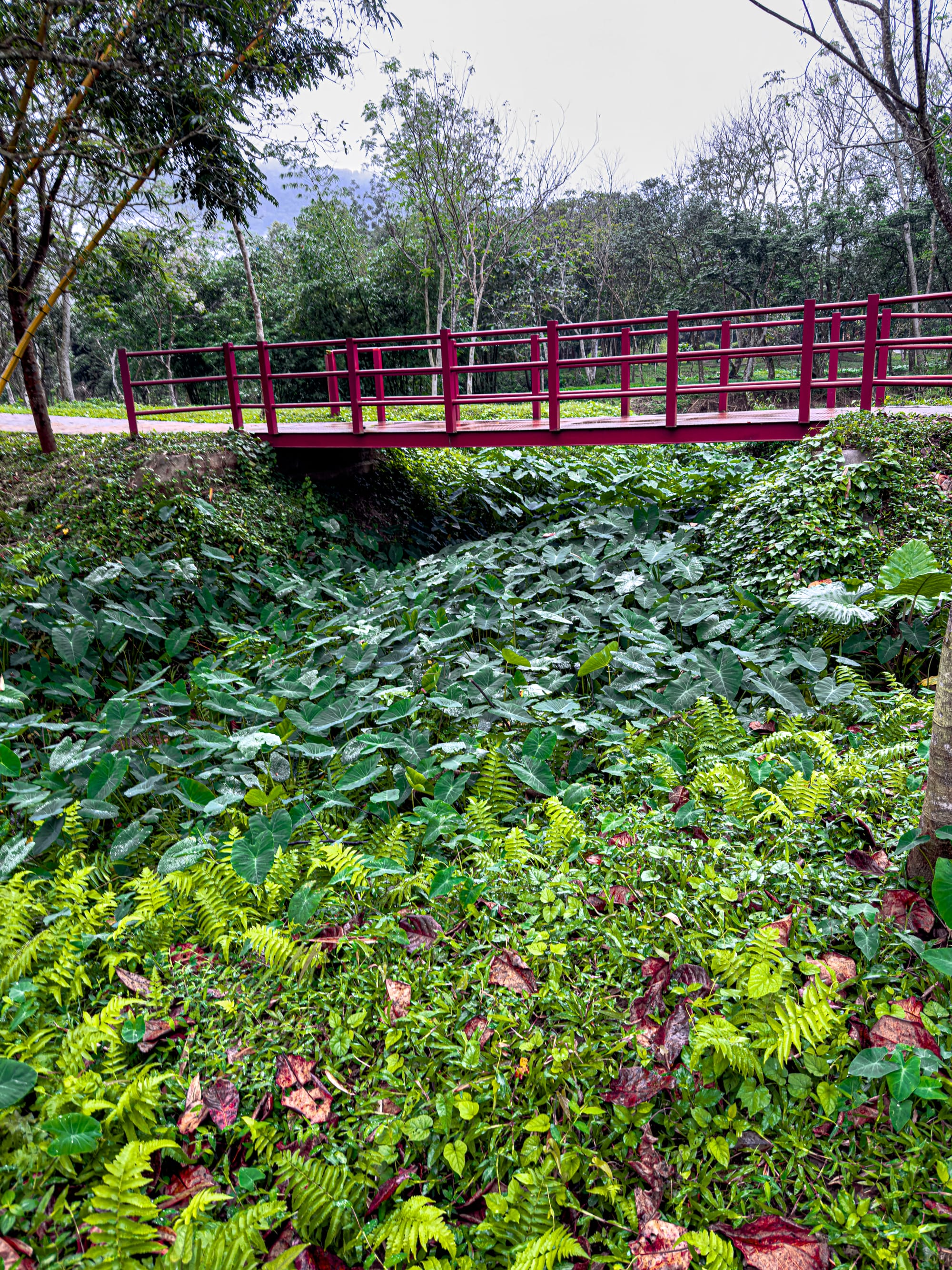
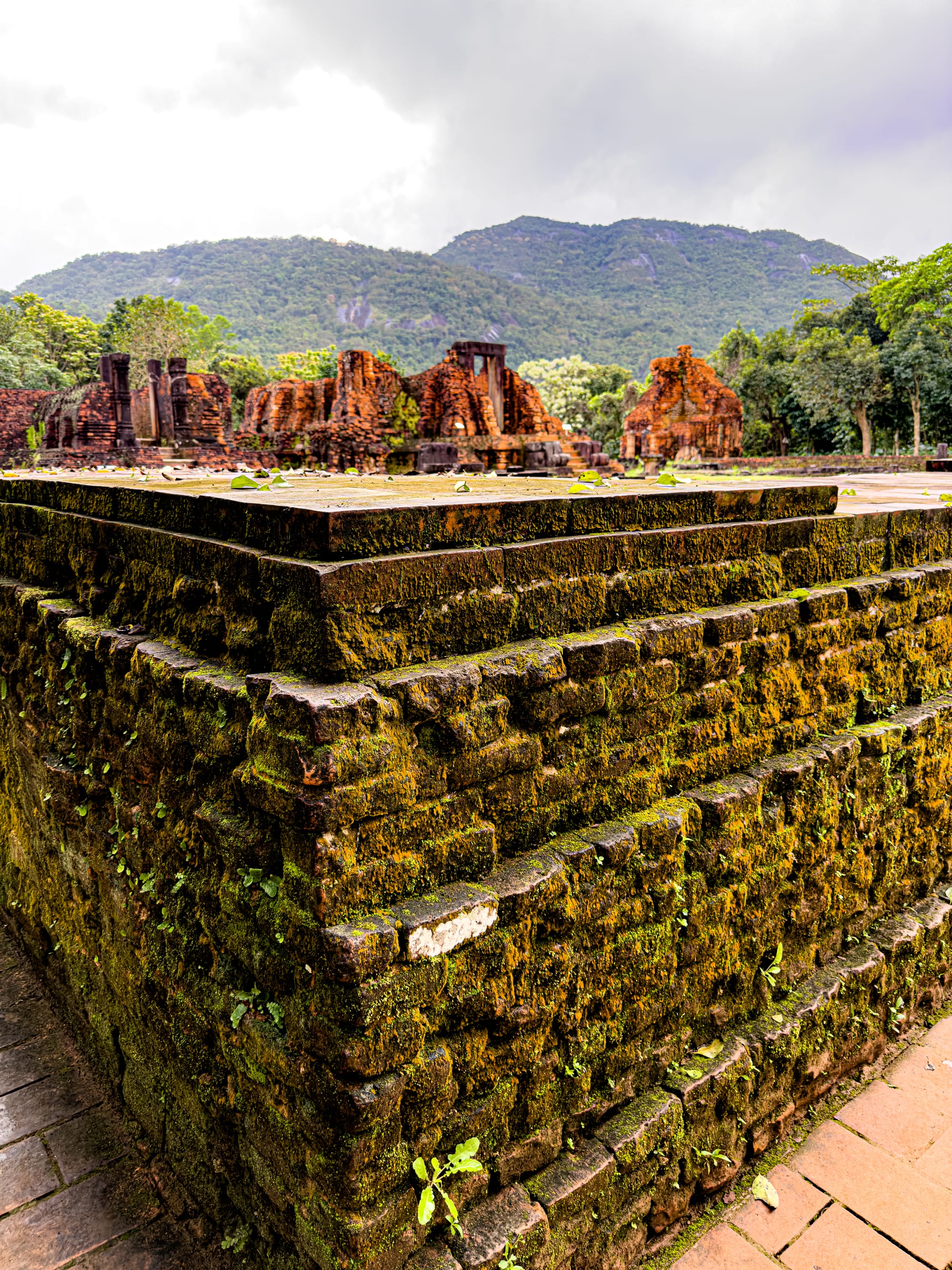
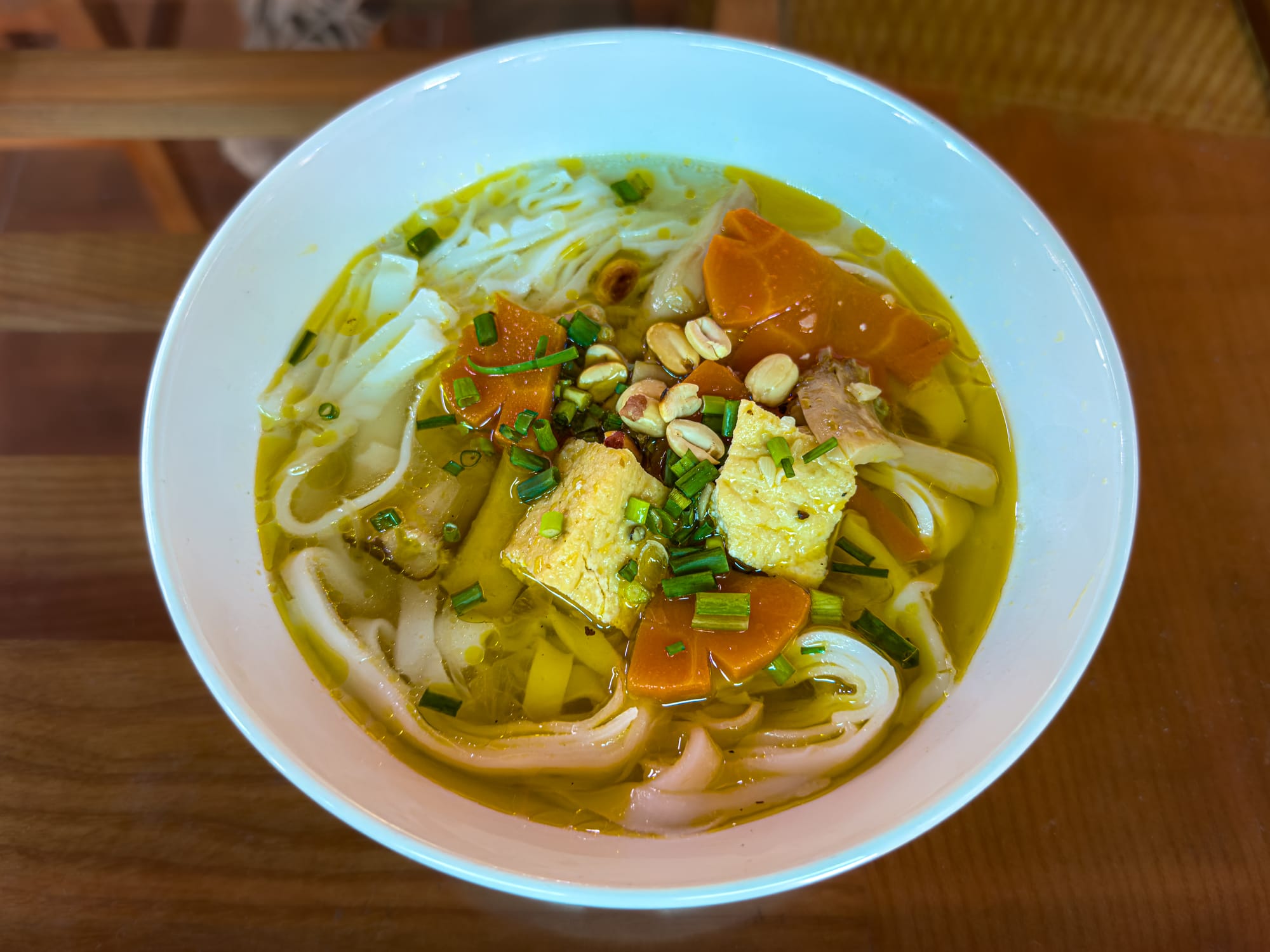
Visitors typically explore on foot along short trails connecting the temple groups, with signs providing historical context. Early morning is the best time to visit, both for cooler air and for fewer crowds. Guided tours from Hội An are common. While much of the site was damaged during war, the remaining structures and ongoing restoration work make it an engaging glimpse into the region’s layered past.
The Marble Mountains
Caves, temples, and views just outside Đà Nẵng.
Located between Hội An and Đà Nẵng, the Marble Mountains are a cluster of five limestone and marble hills, each named after an element. The most visited is Thủy Sơn (Water Mountain), which can be explored via a network of stairways, pagodas, and caves filled with Buddhist shrines. Some caves open into vaulted chambers lit by shafts of sunlight, while others are small and atmospheric, with incense smoke hanging in the air.
From the top, viewpoints look out over the coastline, Đà Nẵng city, and the surrounding plains. The site is compact but layered, making it an easy half-day trip from Hội An by motorbike, taxi, or tour. Go in the morning or late afternoon to avoid the heat, and expect a bit of climbing—there are both traditional stone steps and an elevator for easier access. It’s a good balance of cultural interest, light adventure, and sweeping views.
Hue, the Imperial City
Vietnam’s Imperial City on the Perfume River.
Roughly three hours north of Hội An, Huế was once the capital of Vietnam and remains home to some of the country’s most important historical sites. At the center is the Imperial City, a walled complex of palaces, temples, and gates built during the Nguyễn Dynasty. Though parts were damaged during war, much has been restored, and walking through the citadel gives a sense of the city’s former grandeur. Beyond the walls, Huế is also known for its royal tombs, pagodas, and riverside gardens.
Most travelers visit Huế as a full-day trip, either by train, car, or organized tour. The journey itself is a highlight if you take the Hải Vân Pass—a coastal mountain road with sweeping ocean views and frequent photo stops. Once in the city, you can explore the main sights on foot, and sample Huế’s distinctive cuisine, which includes vegetarian dishes traditionally prepared for Buddhist monks. It’s a long day from Hội An, but worthwhile for those interested in Vietnam’s imperial history.
Bach Ma National Park
Waterfalls and viewpoints in the mountains.
Located about two hours from Hội An, Bạch Mã National Park offers a mix of mountain scenery, dense forest, and cool air that makes it a refreshing break from the coast. Once a French hill station, the park is now best known for its hiking trails and waterfalls. Highlights include the Five Lakes Trail, where you can swim in clear pools linked by small cascades, and Rhododendron Falls, a dramatic drop reached by a steep trail. Wildlife enthusiasts may also spot butterflies, birds, and macaques along the paths.
The summit of Bạch Mã rises to 1,450 meters, with panoramic views over the lagoons and coastline below. Trails vary in length and difficulty, so you can spend a few hours or a full day depending on your energy and schedule. The park is easiest to visit with a driver or organized tour, though experienced riders sometimes go by motorbike. Bring good shoes, insect repellent, and plenty of water—the trails are beautiful but can be humid and slippery.
Nui Than Tai Hot Springs Park
A spa-style retreat in the hills outside Đà Nẵng.
About 40 km from Hội An, Núi Thần Tài Hot Springs Park is a large wellness and recreation area built around natural mineral springs. The park combines hot spring bathing with a mix of facilities—stone pools, mud baths, water slides, and landscaped gardens set against the backdrop of Ba Na Hills. Visitors can soak in warm mineral water, try out themed pools infused with herbs or tea, or book treatments like mud therapy and onsen-style baths.
It’s a popular spot for both families and groups, with a balance of relaxation and light amusement-park energy. While some areas lean more toward entertainment, there are quieter pools and private baths available if you want a calmer experience. The park is easiest to reach by car or motorbike from Hội An or Đà Nẵng, and it works well as part of a combined day trip with nearby Ba Na Hills. Bring swimwear and expect to spend at least half a day if you want to make the most of the facilities.
Cham Islands snorkeling
Marine reserves a short boat ride away.
About 15 km off the coast from Hội An, the Chàm Islands form part of a UNESCO Biosphere Reserve known for its coral reefs and clear water. Day trips usually start with a speedboat ride from Cửa Đại harbor, followed by a few hours of snorkeling at designated sites. You’ll see colorful fish, coral gardens, and sometimes sea turtles, depending on the season and conditions. After snorkeling, most tours include time on the beach with a simple seafood or vegetarian lunch.
The main season runs from March to September, when seas are calm and visibility is best. Outside of these months, the islands are often closed due to rough water. Trips can be booked through local tour agencies or directly at the harbor, and they typically take up most of the day. While not as pristine as more remote dive destinations in Southeast Asia, the Chàm Islands offer an easy, worthwhile escape into nature—especially for anyone wanting a balance of water activity and island scenery.
The Golden Bridge
An iconic viewpoint in the Ba Na Hills.
The Golden Bridge, held aloft by two giant stone hands, has become one of Vietnam’s most photographed landmarks. Located in the Bà Nà Hills resort area about 1.5 hours from Hội An, the pedestrian bridge offers sweeping views over the mountains and valleys. The structure itself is short—just 150 meters long—but the design and the panorama make it worth the visit, especially in clear weather.
To reach the bridge, visitors take a cable car up the mountain, which is an experience in itself and one of the longest in the world. Because the bridge is part of the larger Bà Nà Hills complex, entry requires a full-day ticket that includes access to other attractions like gardens, temples, and a French-themed village. The bridge gets busiest in the middle of the day, so aim for early morning or late afternoon to enjoy it with fewer crowds and softer light.
Hai Van Pass
A coastal road through mountains and mist.
Stretching 21 km between Đà Nẵng and Huế, the Hải Vân Pass is one of Vietnam’s most scenic drives. The road winds up through lush mountains, with sweeping views over the coastline on one side and steep cliffs on the other. At its summit, you’ll find a viewpoint with remnants of French and American bunkers, as well as panoramic looks back toward Đà Nẵng Bay. On clear days the vistas are spectacular, while in mist or rain the pass takes on a dramatic, atmospheric feel.
Most visitors experience the pass by motorbike, either renting on their own or booking an “easy rider” tour where a driver takes care of the bike and you ride on the back. It can also be crossed by car or train, though the motorbike experience is the most popular. The route takes about 45 minutes to an hour, but many stretch it into a half-day trip with stops for photos, seafood lunches, and swimming at nearby beaches. It’s a memorable way to link Hội An or Đà Nẵng with Huế.
Da Nang
A modern city just up the coast.
Only 30 minutes from Hội An, Đà Nẵng is a full contrast to the Old Town: a modern coastal city with high-rises, long beaches, and a more urban pace. The seafront is lined with resorts and seafood restaurants, while the city center has cafés, rooftop bars, and a growing expat and nomad community. Key landmarks include the Dragon Bridge, which breathes fire and water on weekend nights, and the Marble Mountains, with pagodas and caves set into limestone hills on the city’s edge.
Đà Nẵng works well as a day trip for variety—whether you want a city break, international dining, or simply a change of scenery from Hội An’s slower rhythm. It’s also a gateway for onward travel, with the region’s main airport, train station, and bus links. Many nomads base themselves here for coworking options and nightlife, then dip into Hội An for its charm. Visiting both gives you a fuller sense of what Central Vietnam has to offer.
Essential tools for Hoi An
For nomads living and working from Hội An, these tools made our stay smoother.
Saily Global eSIM
Instant global mobile data without needing a local SIM. Saily global eSIM gives you mobile data in Vietnam and dozens of other countries—no need to buy a separate local SIM when you arrive. Great for digital nomads who hop between places and want one seamless solution that works everywhere.
SafetyWing (global health & travel insurance)
An affordable, digital-nomad-friendly insurance plan that covers both travel hiccups and medical needs. We like that it runs month-to-month and can be started even if you’re already abroad. Helpful for peace of mind, especially on remote islands where care may require transfers or added costs.
NordVPN
A lightweight, fast VPN that lets you secure your connection on public wifi—especially important when working from colivings, cafes, or airports. It also lets you access content as if you were back home, which is helpful for banking, streaming, or logging into sensitive accounts.
Wise (multi-currency payments)
Our favorite banking solution for multi-currency payments and avoiding bad exchange rates. Wise lets you pay in Vietnamese đồng locally and manage funds across dozens of currencies. We used it to split group dinners, pay for tours, and withdraw cash without the large fees traditional banks charge.
Should you choose Hoi An?
Hội An's community is centered around Hub Hoi An, surrounded by rice fields. Life moves at a slower pace here: bicycles, lantern-lit evenings instead of nightlife districts. If you’re looking for an intimate, easy-to-navigate base with strong food culture and a balance of focus and leisure, Hội An is hard to beat.
The pros?
- A tight-knit digital nomad community centered on Hub Hoi An
- Affordable cost of living compared to much of Southeast Asia
- Excellent vegan food scene and diverse dining options
- Cycling routes through rice fields and quick access to An Bàng Beach
- Rich local culture and heritage in the Old Town
- Easy access to Đà Nẵng, Huế, and central Vietnam day trips
The trade-offs?
- The rainy season (November–January) can bring flooding and damp conditions
- Tourist crowds in the Old Town, especially in high season
Hội An is for those who want balance: a small, friendly community, an affordable and manageable base, and a chance to root in Vietnamese culture without being swept along by a hyper-nomad scene. If you work better in calm environments, and like your days framed by bicycles, rice paddies, and lantern light, it’s an excellent choice.
Read more
If you’re curious about how to make Hội An work for you, we’ve written extensively about our experience. Check out our Hội An guides for more information on what we enjoyed in the region.






